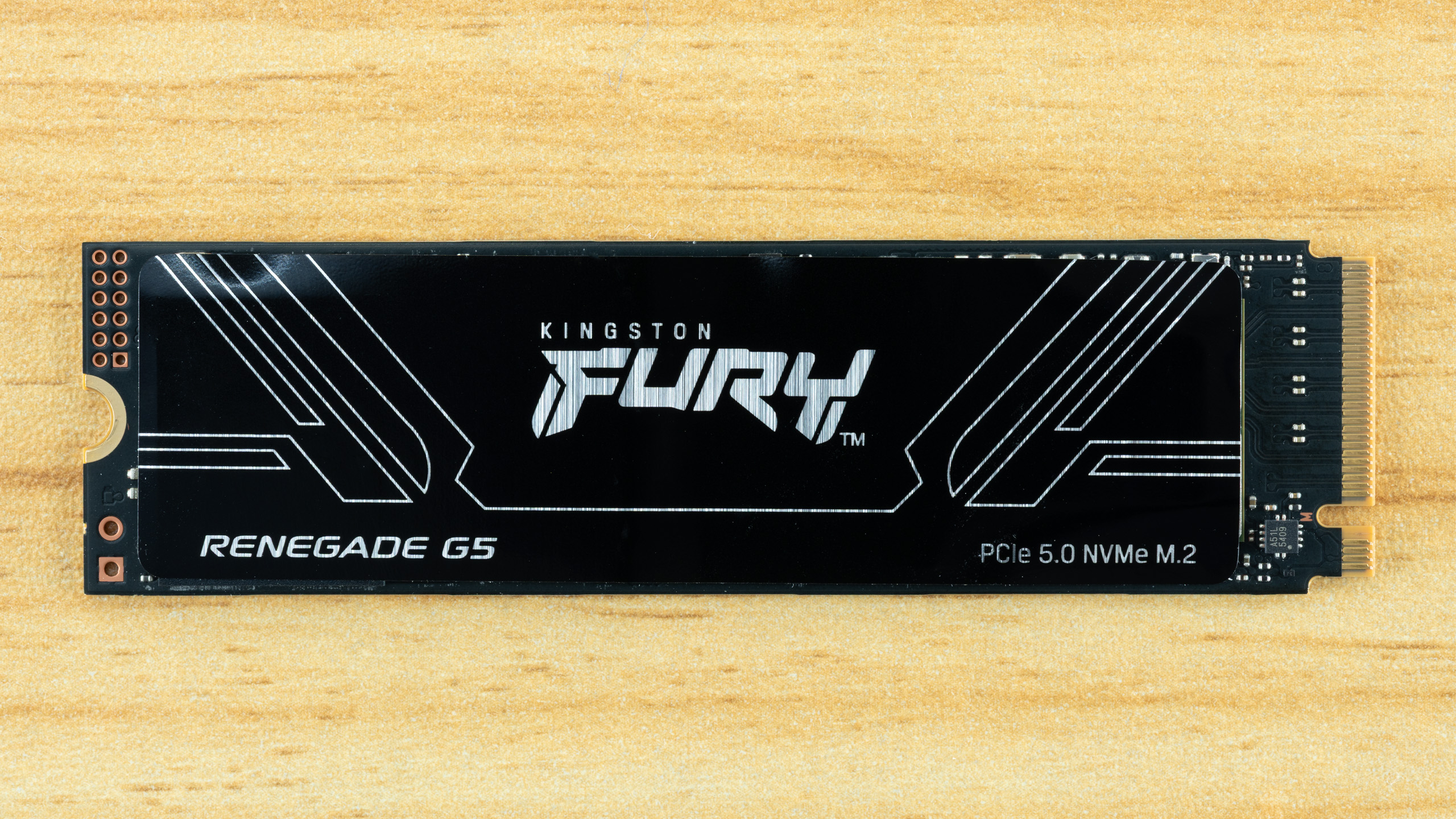Why you can trust Tom's Hardware
Comparison Products
We have a diverse set of competing drives. The QLC drive of the hour is the Crucial P310, a more recent release that threatens to take market share from existing budget drives. The Kingston NV3 is a stalwart opponent in this arena, typically featuring QLC flash, even though our release sample used TLC. Technically, the P310 is replacing the popular P3 Plus, which uses the same hardware as the Corsair MP600 Core XT. The FA200, like the P310, is capable of pumping out more bandwidth, which can translate to improved overall performance.
We then look at drives that share the FA200’s controller but have different flash memory. This includes the Addlink A93 with YMTC TLC flash, and the Klevv CRAS C925 with rarer SK hynix TLC. We also have the Inland TN470, which shows off Phison’s comparable E27T controller. These drives are all roughly in the same class and can perform similarly; however, price and flash capacity must factor into your decision. QLC flash might yield the same performance for what you intend to do with the drive, but if you’re not saving money, then why not go with TLC?
We also want to demonstrate how this drive compares to some of the better PCIe 4.0 drives. We would generally recommend the Samsung 990 Pro, but the 4TB 990 Pro is specifically the best drive to compare, as it’s likely the best 4TB PCIe 4.0 drive on the market. To save money, many people opt to keep the DRAM but switch to an older platform, such as Phison’s E18. The Netac NV7000 is a fair representative of this controller in a mature state. The E18 remains a popular choice for “budget” capacity – we mention the MSI M480 Pro in our conclusion – despite being a higher-end platform on paper. The E18 has recently been known to experience a read performance issue in some cases, but firmware is being or will be released to address this issue.
Trace Testing — 3DMark Storage Benchmark
Built for gamers, 3DMark’s Storage Benchmark focuses on real-world gaming performance. Each round in this benchmark stresses storage based on gaming activities including loading games, saving progress, installing game files, and recording gameplay video streams. Future gaming benchmarks will be DirectStorage-inclusive and we also include notes about which drives may be future-proofed.
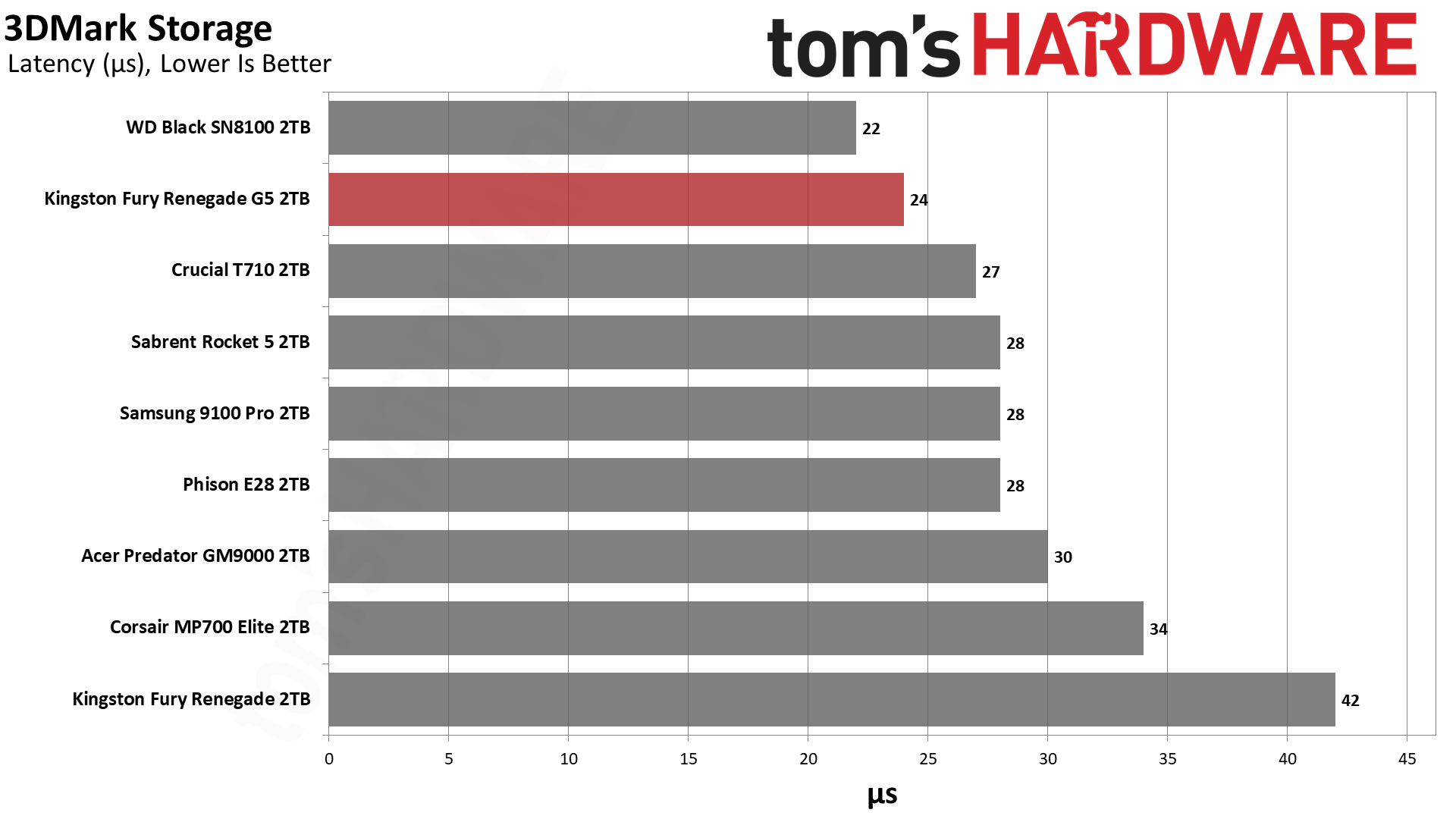
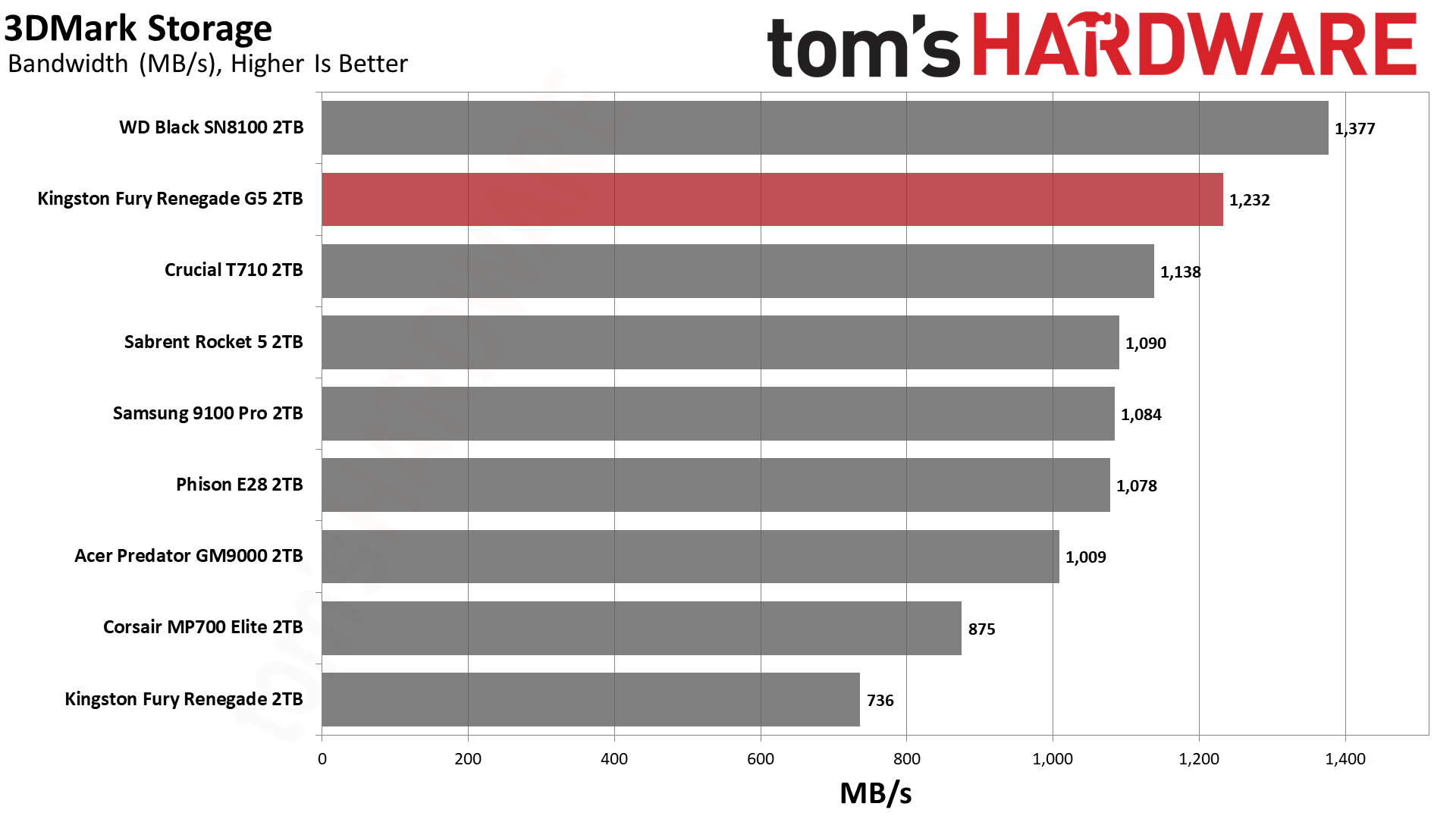
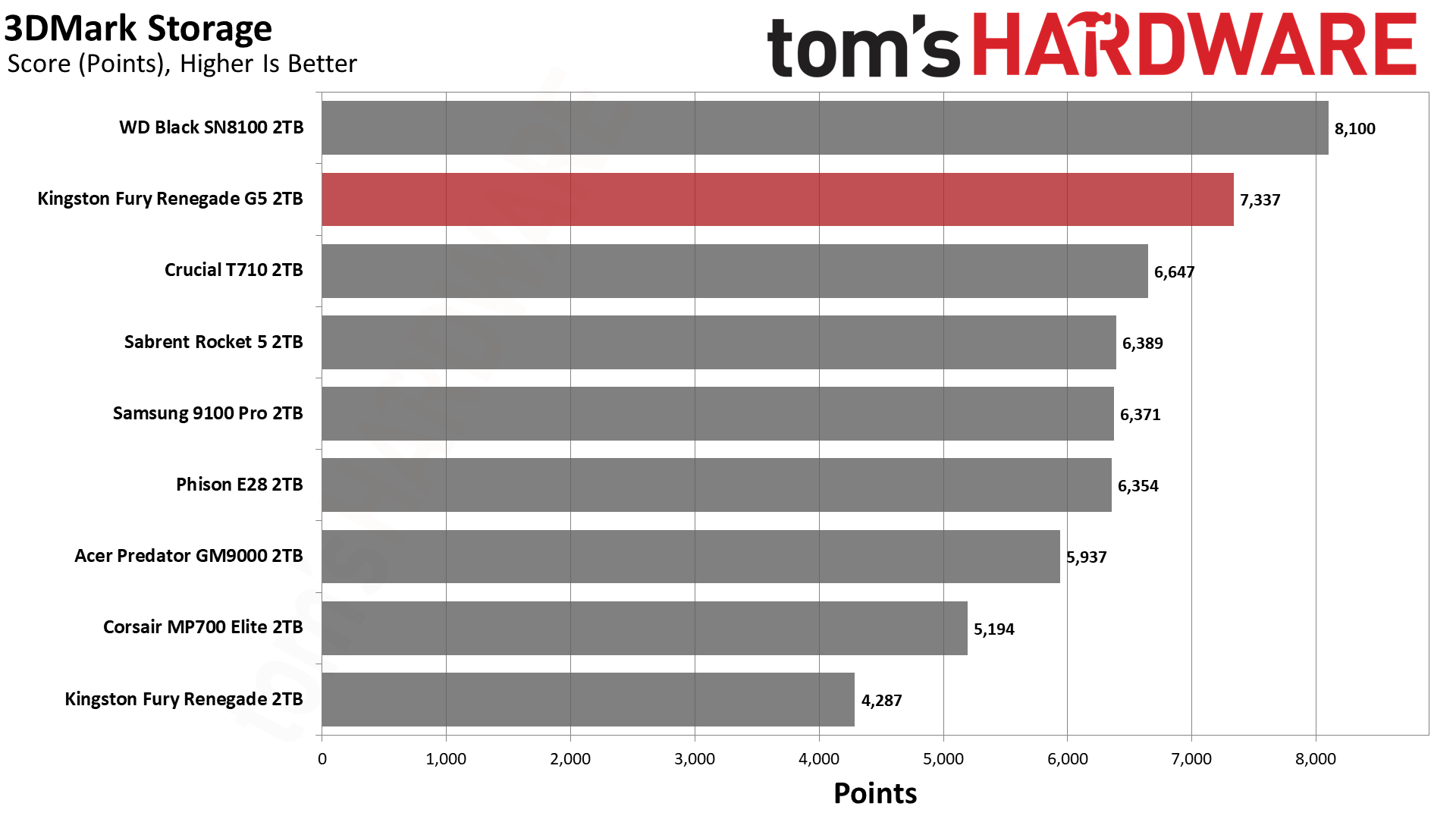
Want a killer drive for your high-end gaming setup? The Fury Renegade G5 would be on our short list. The Black SN8100 scores a bit better, probably due to SanDisk’s firmware optimization. Sometimes this optimization might only appear in benchmarks like this, so some caution is warranted. To be on the safe side, we would put the Renegade G5 right up against the Black SN8100 in a real-world contest, but at the same price, we’d lean towards the latter. SanDisk’s inherited WD Dashboard is pretty solid, so that’s an extra edge.
The T710, which uses Micron rather than Kioxia TLC flash, comes in third place. Micron’s flash is technically more advanced as it has more layers – 276 against 218 – but historically speaking BiCS has trailed in layer count but made things work in other ways. In the past, this might have been due to capacity – the 8TB E18-based drives still use BiCS5 instead of the 176-Layer Micron flash with lower launch capacities, or in cost. With BiCS8 on the Black SN8100 and Fury Renegade G5, the advantages are two-fold: the flash is using a power-efficient architecture, and by staying with a four-plane design, Kioxia/SanDisk has managed a decent improvement to random read performance.
Micron’s flash, on the other hand, can achieve higher parallelization at any capacity as it uses a six-plane design. This means six-way internal interleaving is possible per die, rather than four-way. As a result, the T710 generally has better throughput, and this is especially meaningful at 1TB. What does this mean for gaming? Well, in our opinion, you’re probably better served by going with a BiCS8-based drive to shave off every nanosecond, even if it means games might transfer over slightly slower. This objectively puts the Black SN8100 and Fury Renegade G5 into a class of their own. If you’re going to go all-out and spend money on a PCIe 5.0 drive for gaming, you might as well get the very fastest one.
Get Tom's Hardware's best news and in-depth reviews, straight to your inbox.
Then again, if you’re budget-conscious we would say any drive will do. The SanDisk WD Black SN7100 is a good choice because it’s well-rounded and relatively inexpensive, especially at larger capacities. If you’re a Samsung fan and want a PCIe 5.0 drive, the 9100 Pro will do just fine. And if you’re rocking an older PCIe 5.0 drive, you probably won’t notice the difference with an upgrade.
On the other hand, the advantage over PCIe 4.0 drives – even relatively high-end ones like the original Fury Renegade – might make you consider a jump up to the G5. After all, your old Fury Renegade will make for a great secondary drive. You might want to look at a drive with the best TB/$ ratio in that case, though, where compromising with an E26-based drive like the Rocket 5 or an SM2508-based drive with older flash – like the Predator GM9000 – might make more sense.
Trace Testing — PCMark 10 Storage Benchmark
PCMark 10 is a trace-based benchmark that uses a wide-ranging set of real-world traces from popular applications and everyday tasks to measure the performance of storage devices. The results are particularly useful when analyzing drives for their use as primary/boot storage devices and in work environments.
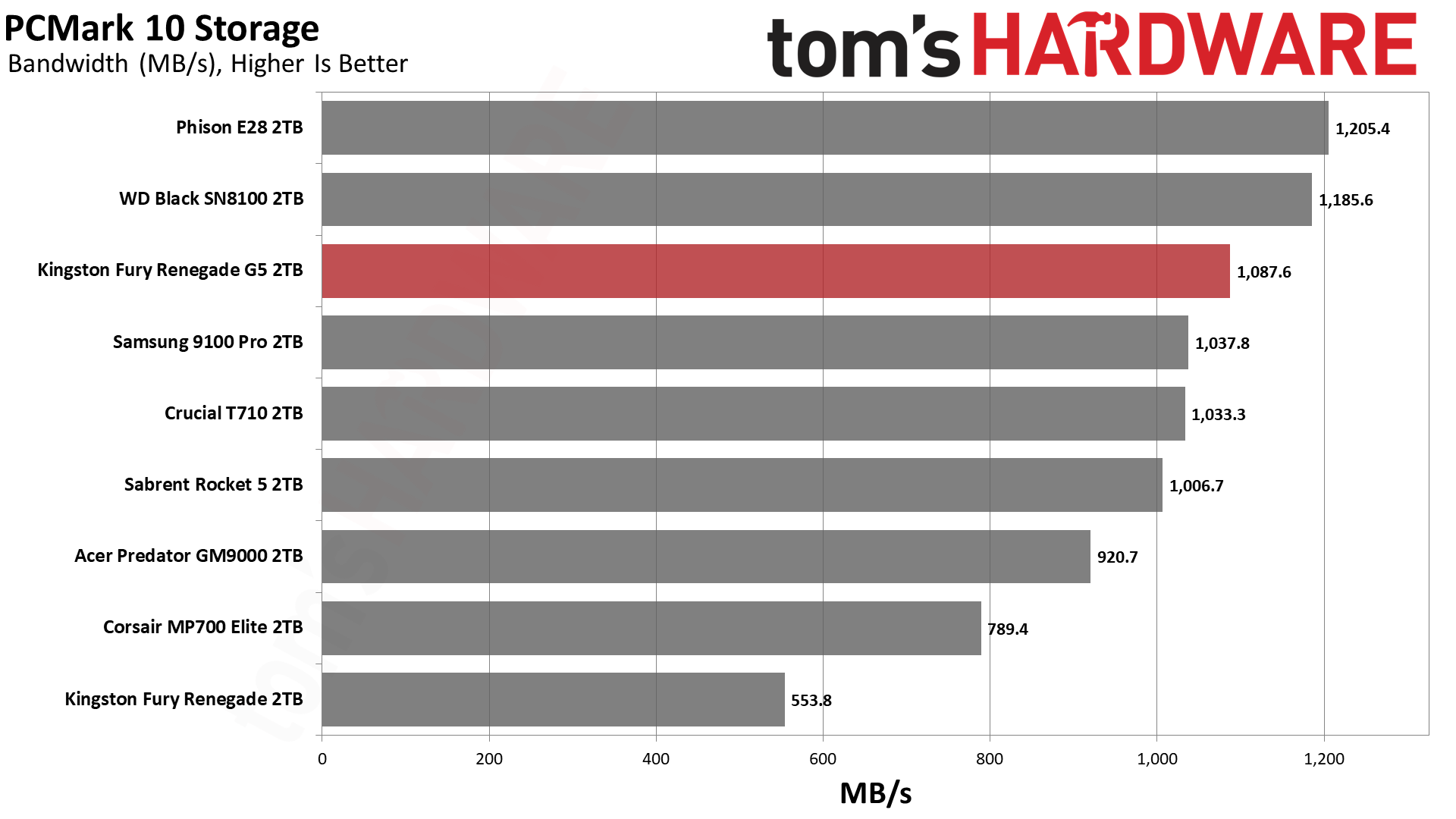
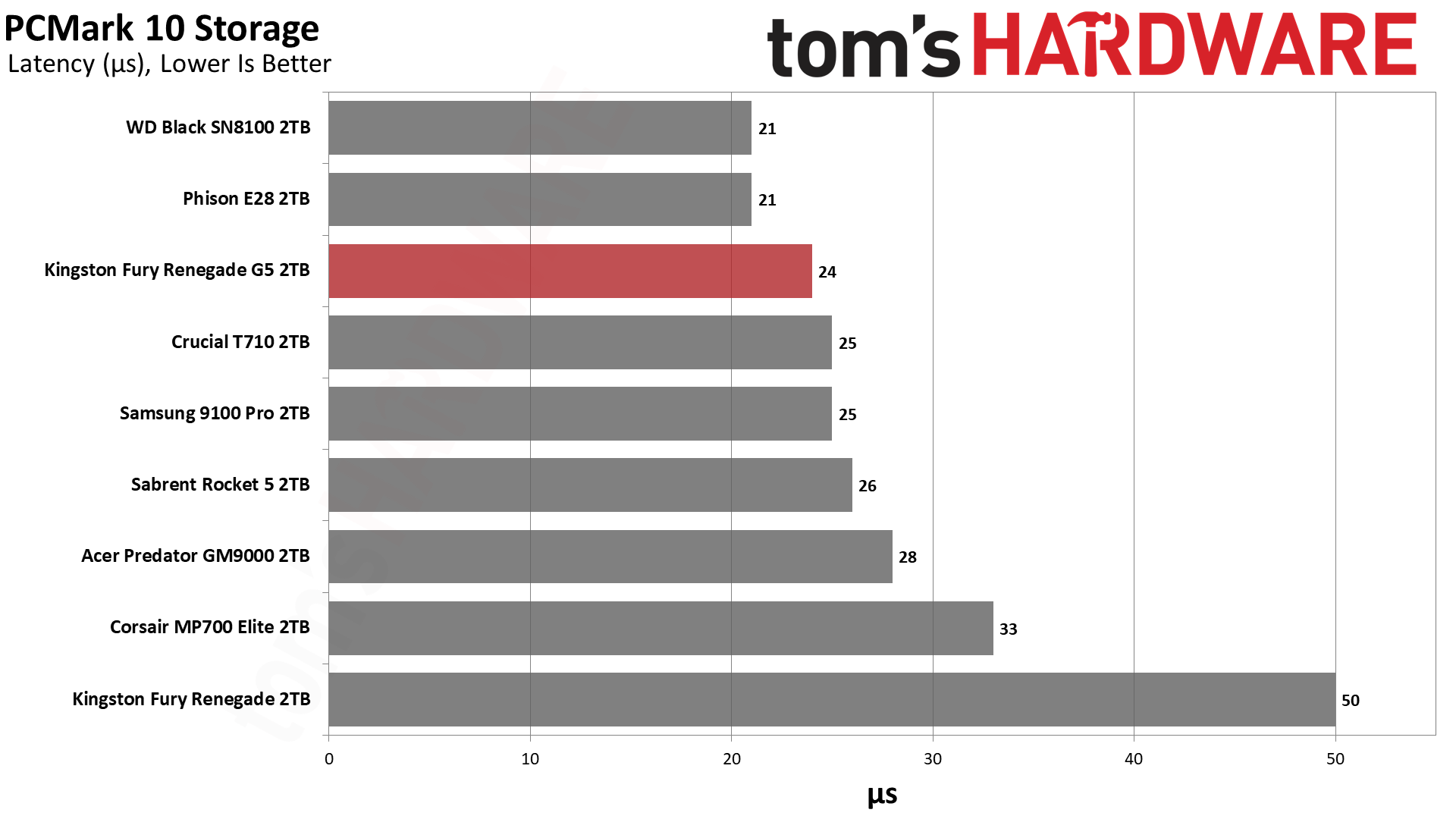
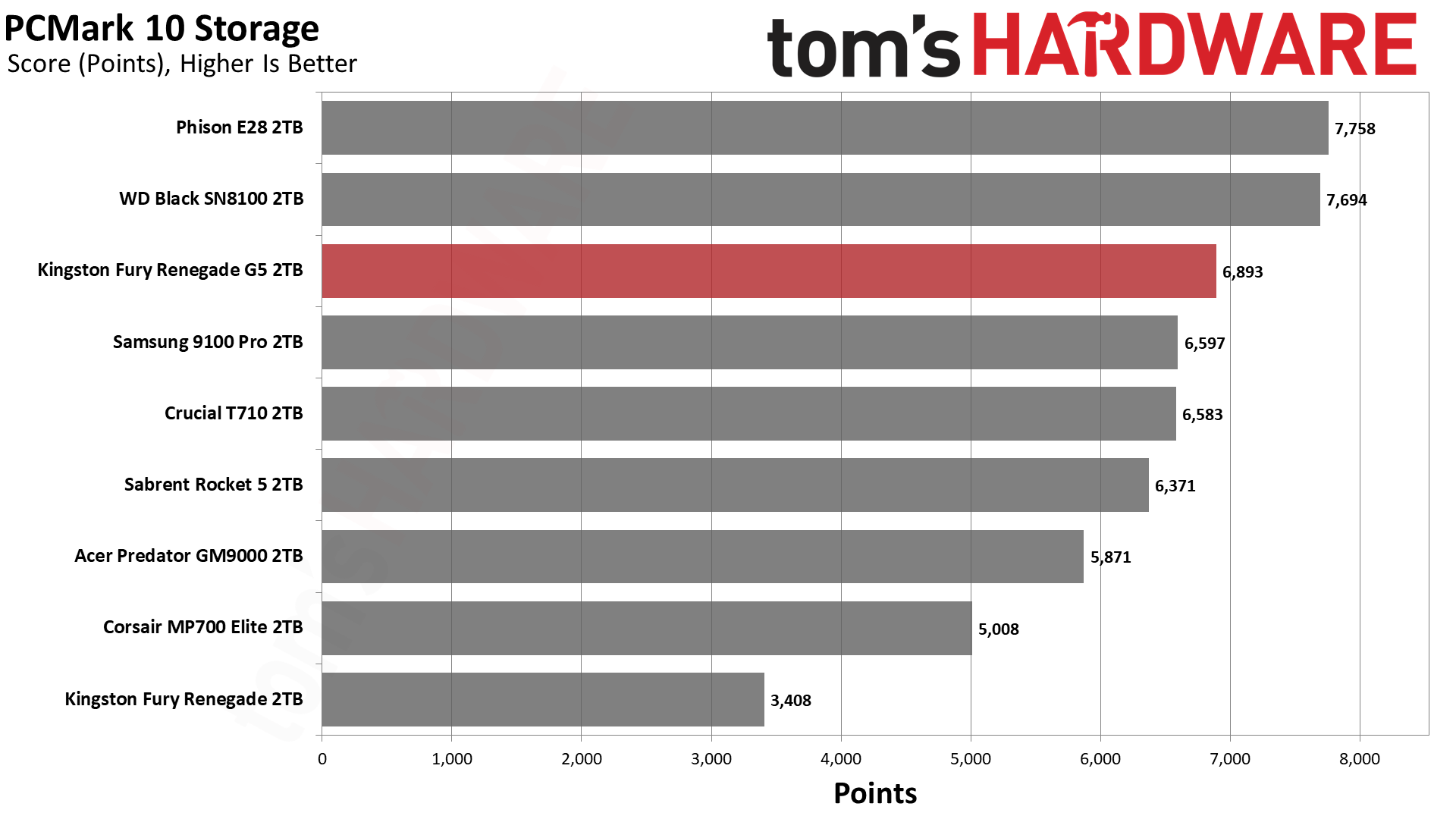
PCMark shows the application side of things in daily Windows usage. Its results are more important for those who use their system for work, content creation, virtualization, server/workstation tasks, and more. PCIe 5.0 drives make more sense for such a user who will undoubtedly have a larger budget and a need for fast storage. It’s pretty clear that the fastest PCIe 5.0 drives blow away any PCIe 4.0 drive when push comes to shove.
Once again, we see SanDisk’s optimization giving great results with the Black SN8100. The only drive that can top it is the one built on Phison’s upcoming E28 SSD controller. Although we said above that Micron’s flash might have throughput benefits, the fact is that Phison has put a lot of effort into getting record-breaking performance out of the E28 while using BiCS8 or any flash for that matter. This hints at a “best of both worlds” approach that means it might be worth waiting if you want a penultimate PCIe 5.0 storage solution. That said, the Black SN8100 is very capable, is available today, and has already been discounted significantly. If the Fury Renegade G5 can undercut that price, it can remain relevant as a safe alternative.
We also think the 9100 Pro and T710 are close enough to consider, the former especially if you want an 8TB solution. We thought that the $999.99 price tag on the 8TB 9100 Pro was not unreasonable, but it was 25% off during the recent Prime Day sale. 50% more than the 8TB WD Black SN850X for double the throughput? That sounds like a good deal for enthusiasts. If you don’t need 8TB, though, you owe it to yourself to be more discerning.
Console Testing — PlayStation 5 Transfers
The PlayStation 5 is capable of taking one additional PCIe 4.0 or faster SSD for extra game storage. While any 4.0 drive will technically work, Sony recommends drives that can deliver at least 5,500 MB/s of sequential read bandwidth for optimal performance. In our testing, PCIe 5.0 SSDs don’t bring much to the table and generally shouldn’t be used in the PS5, especially as they may require additional cooling. Check our Best PS5 SSDs article for more information.
Our testing utilizes the PS5’s internal storage test and manual read/write tests with over 192GB of data both from and to the internal storage. Throttling is prevented where possible to see how each drive operates under ideal conditions. While game load times should not deviate much from drive to drive, our results can indicate which drives may be more responsive in long-term use.
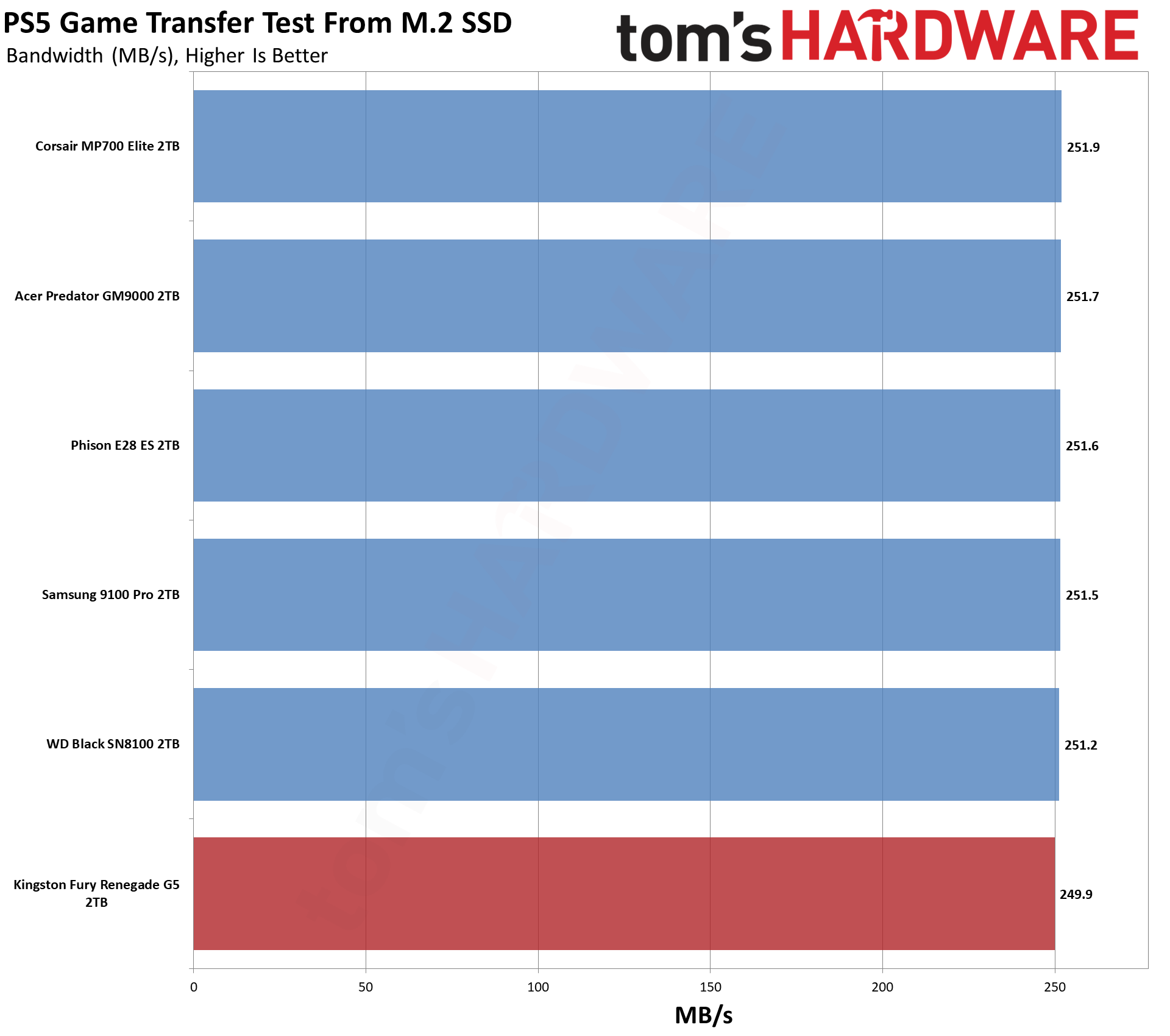
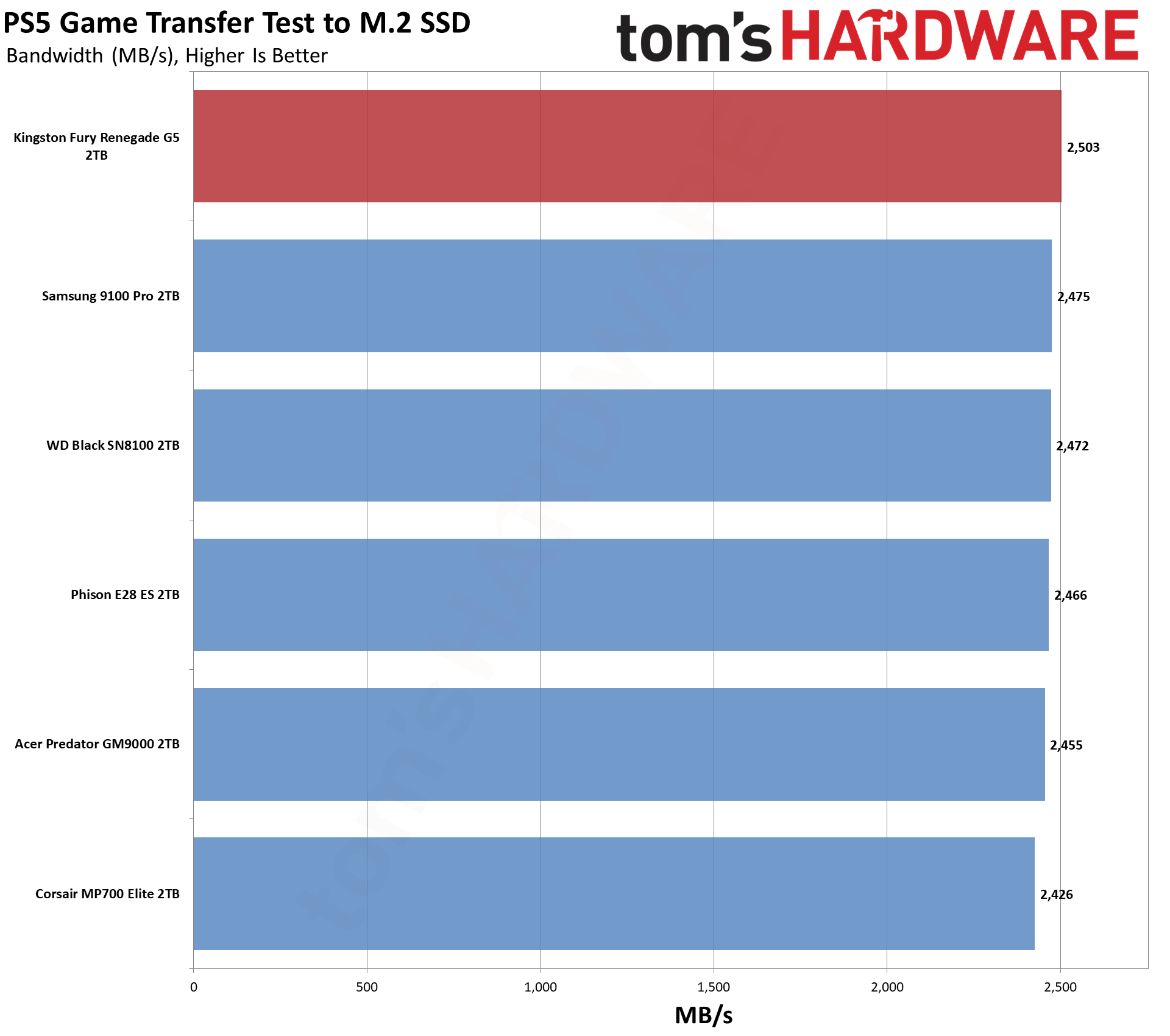
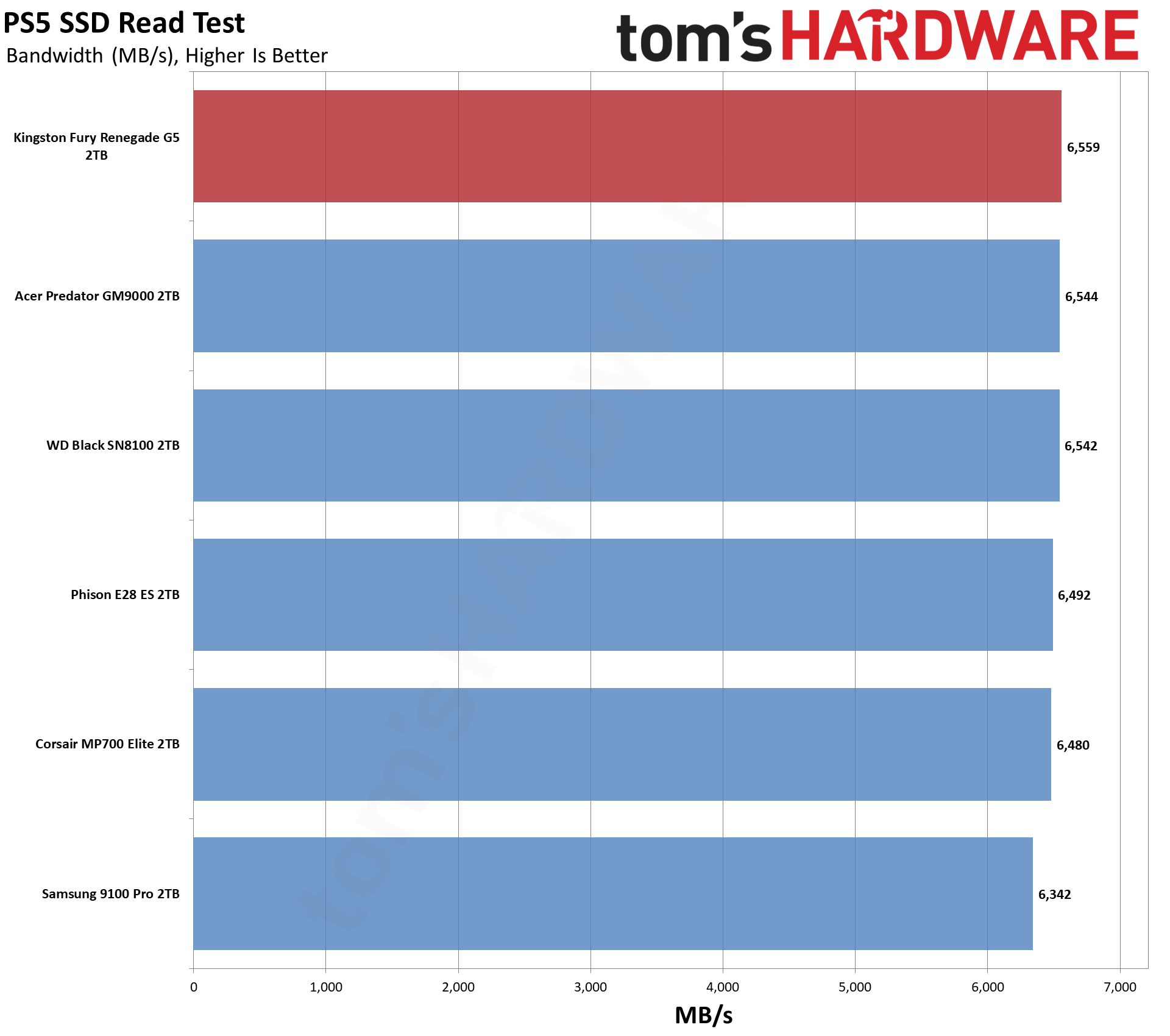
We recommend using a PCIe 4.0 drive for your PS5. A PCIe 5.0 drive like the Fury Renegade G5 is overkill and unnecessary. We still run this test as we’ve discovered anomalies in the past through its results and, some day, PCIe 5.0 drives might end up around the same price point as PCIe 4.0. Consoles can have a long life, and we want to accommodate future readers.
Transfer Rates — DiskBench
We use the DiskBench storage benchmarking tool to test file transfer performance with a custom, 50GB dataset. We write 31,227 files of various types, such as pictures, PDFs, and videos to the test drive, then make a copy of that data to a new folder, and follow up with a reading test of a newly-written 6.5GB zip file. This is a real world type workload that fits into the cache of most drives.
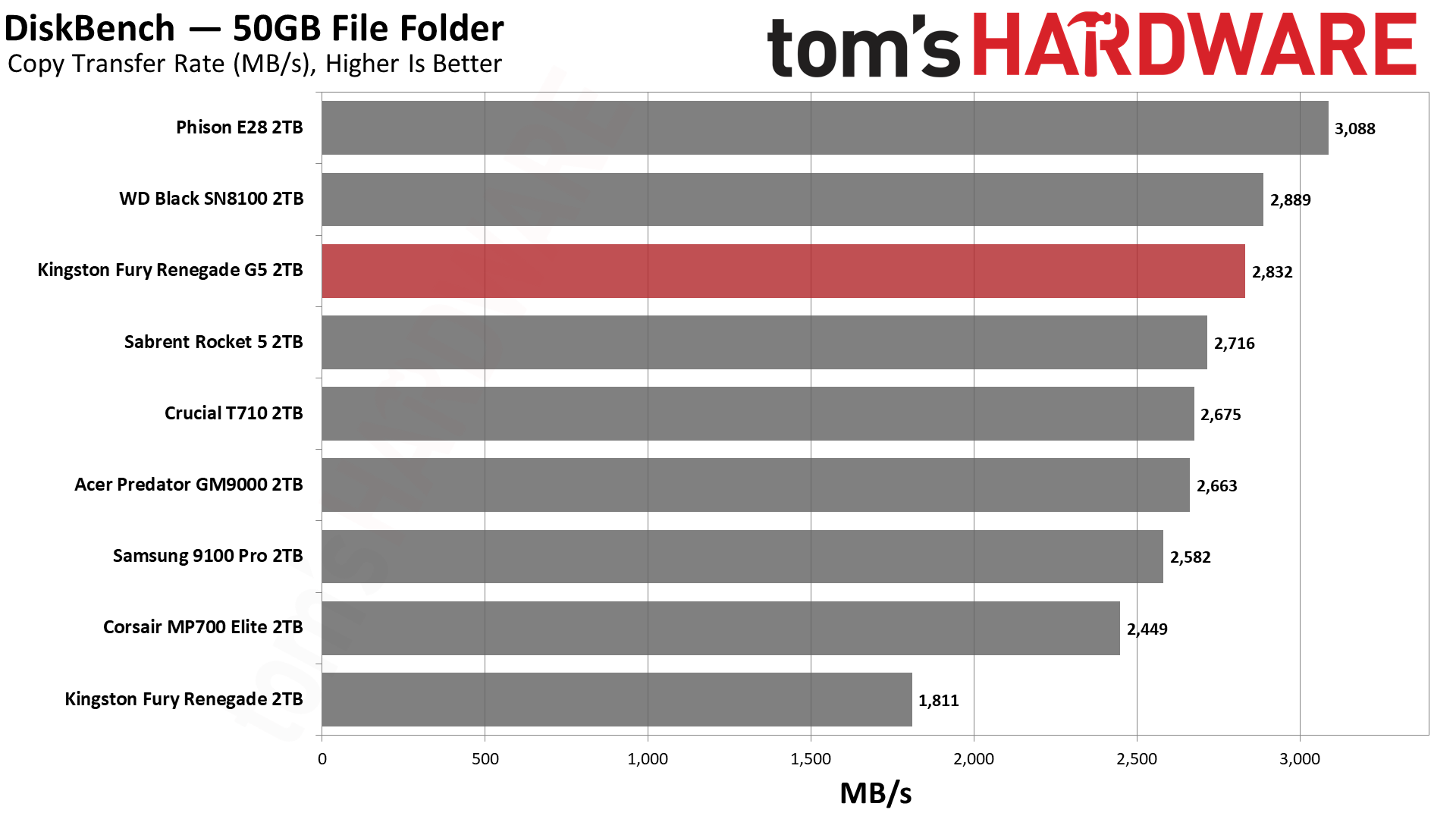
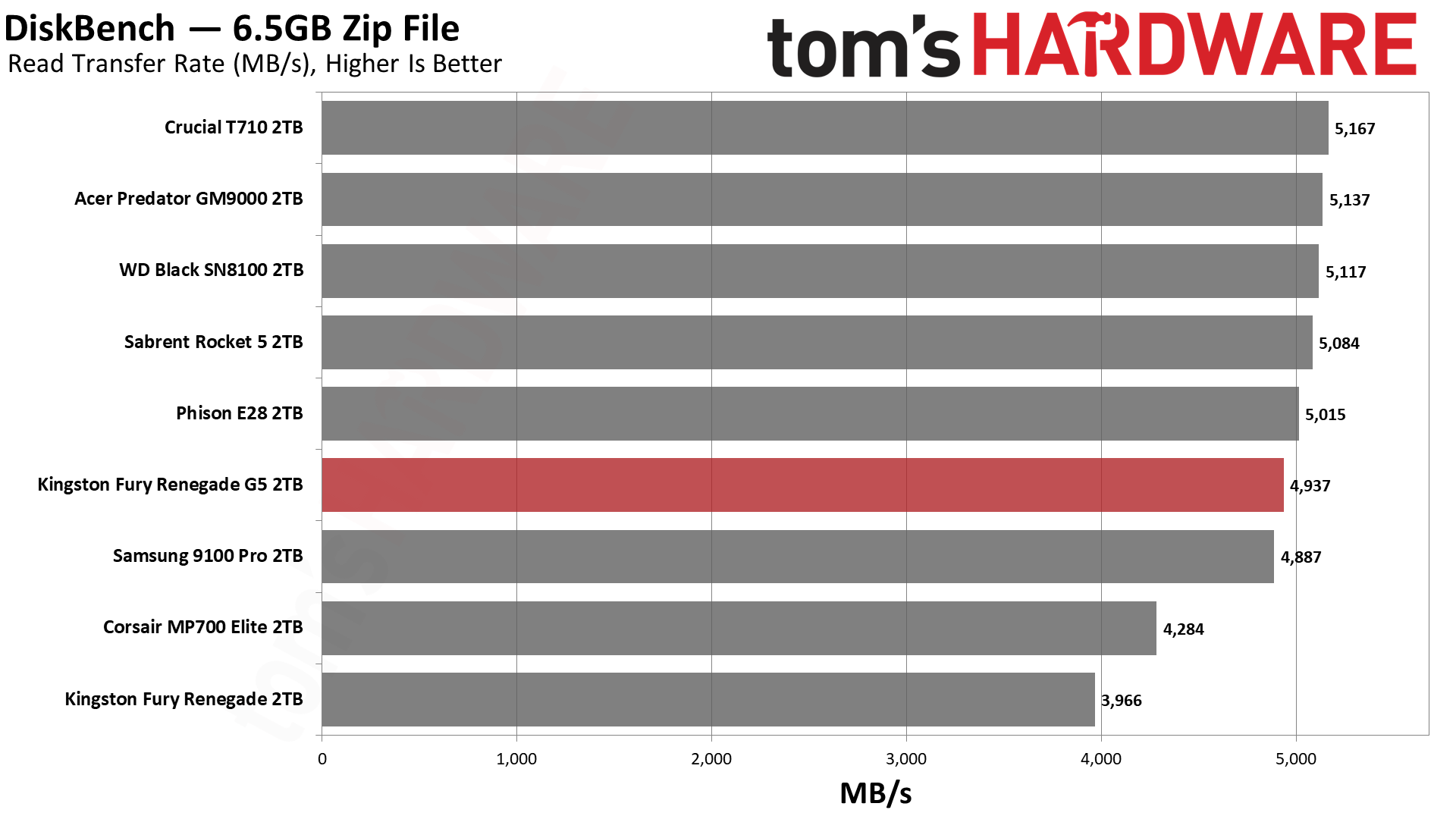
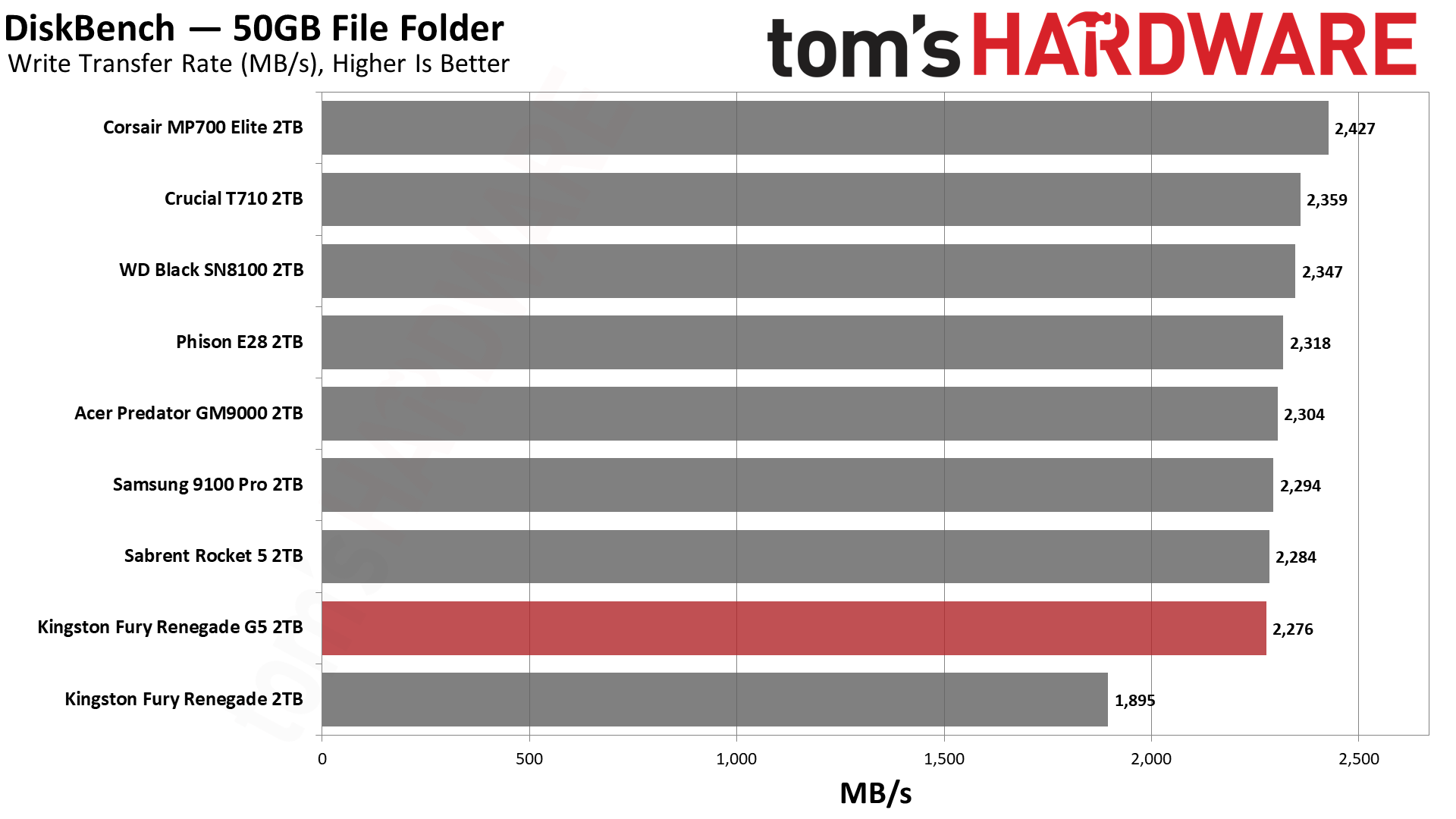
In DiskBench, we again see that Phison is very serious about coming in first place when it comes to showing off what a PCIe 5.0 drive can do. We expect even better things with retail products, assuming some firmware optimization will be implemented. The Black SN8100 and Fury Renegade G5 both perform admirably, too. In fact, even the slower PCIe 5.0 drives, like the MP700 Elite, do great here. That drive is only rated for 10 GB/s or so, and yet it handles itself pretty well, and its BiCS8 TLC flash and E31T controller mean it's efficient, too. The widest gap here is between it and the PCIe 4.0 Fury Renegade, which, for its time, was a fast and popular drive.
Synthetic Testing — ATTO / CrystalDiskMark
ATTO and CrystalDiskMark (CDM) are free and easy-to-use storage benchmarking tools that SSD vendors commonly use to assign performance specifications to their products. Both of these tools give us insight into how each device handles different file sizes and at different queue depths for both sequential and random workloads.
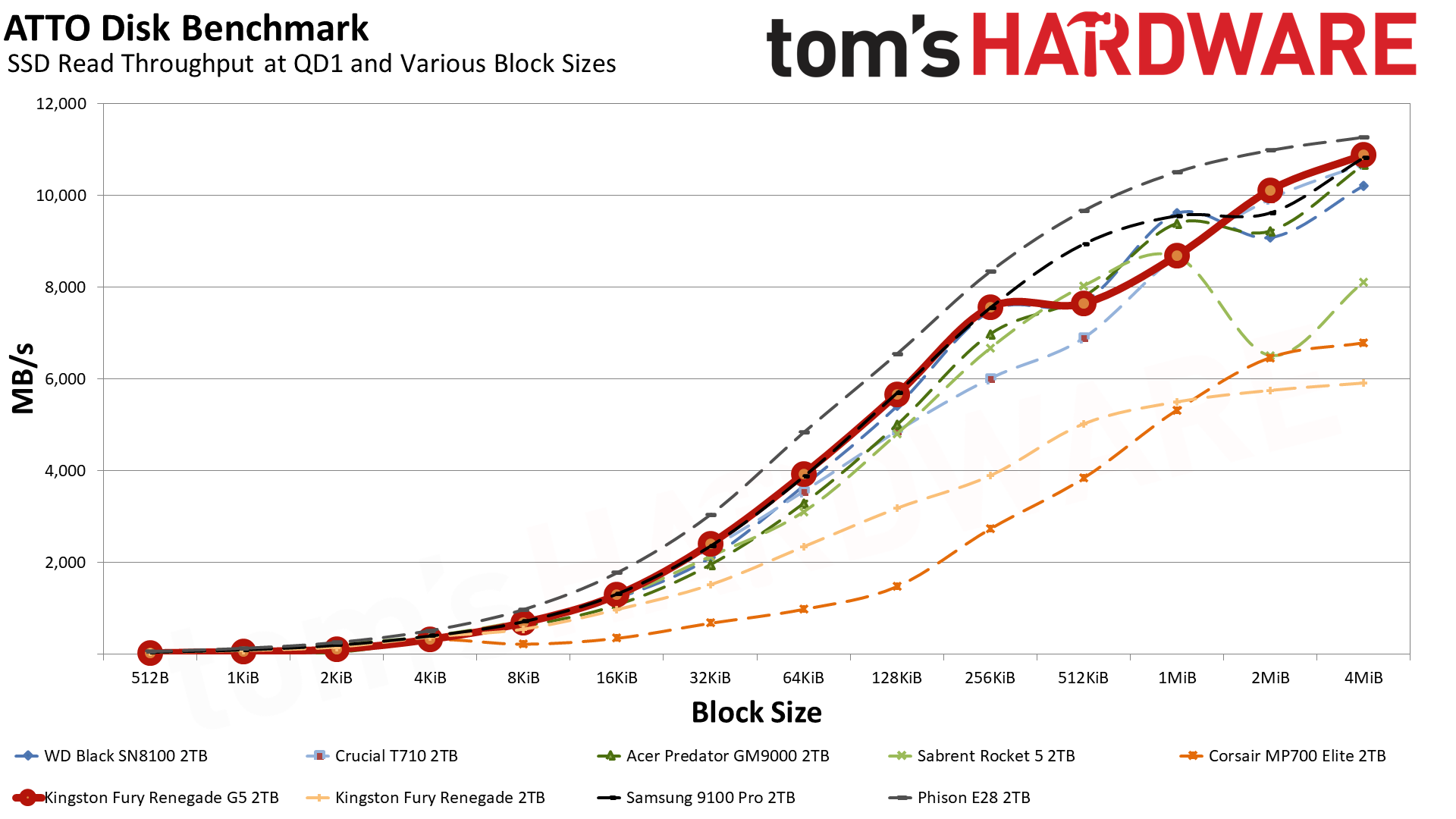
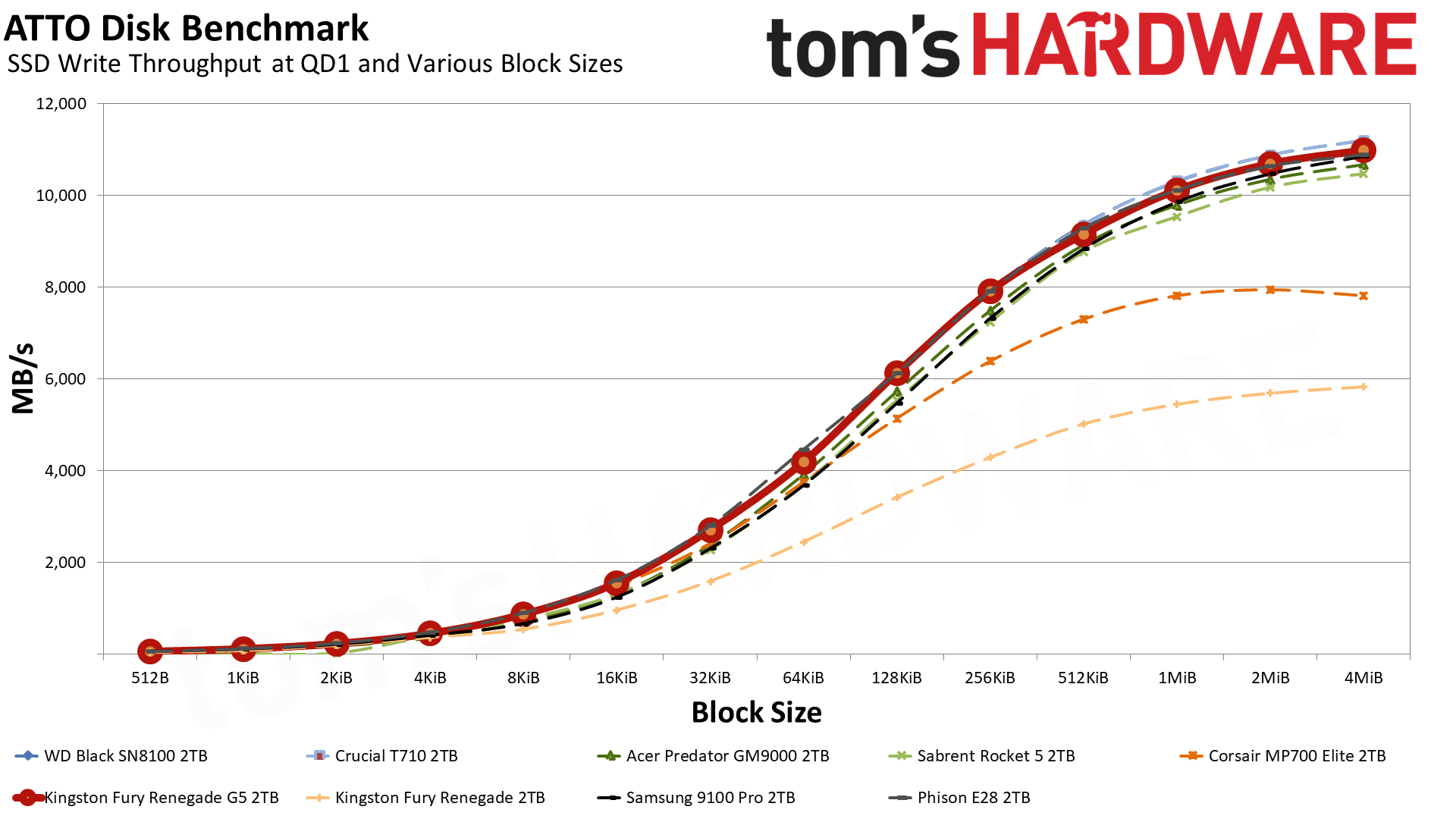
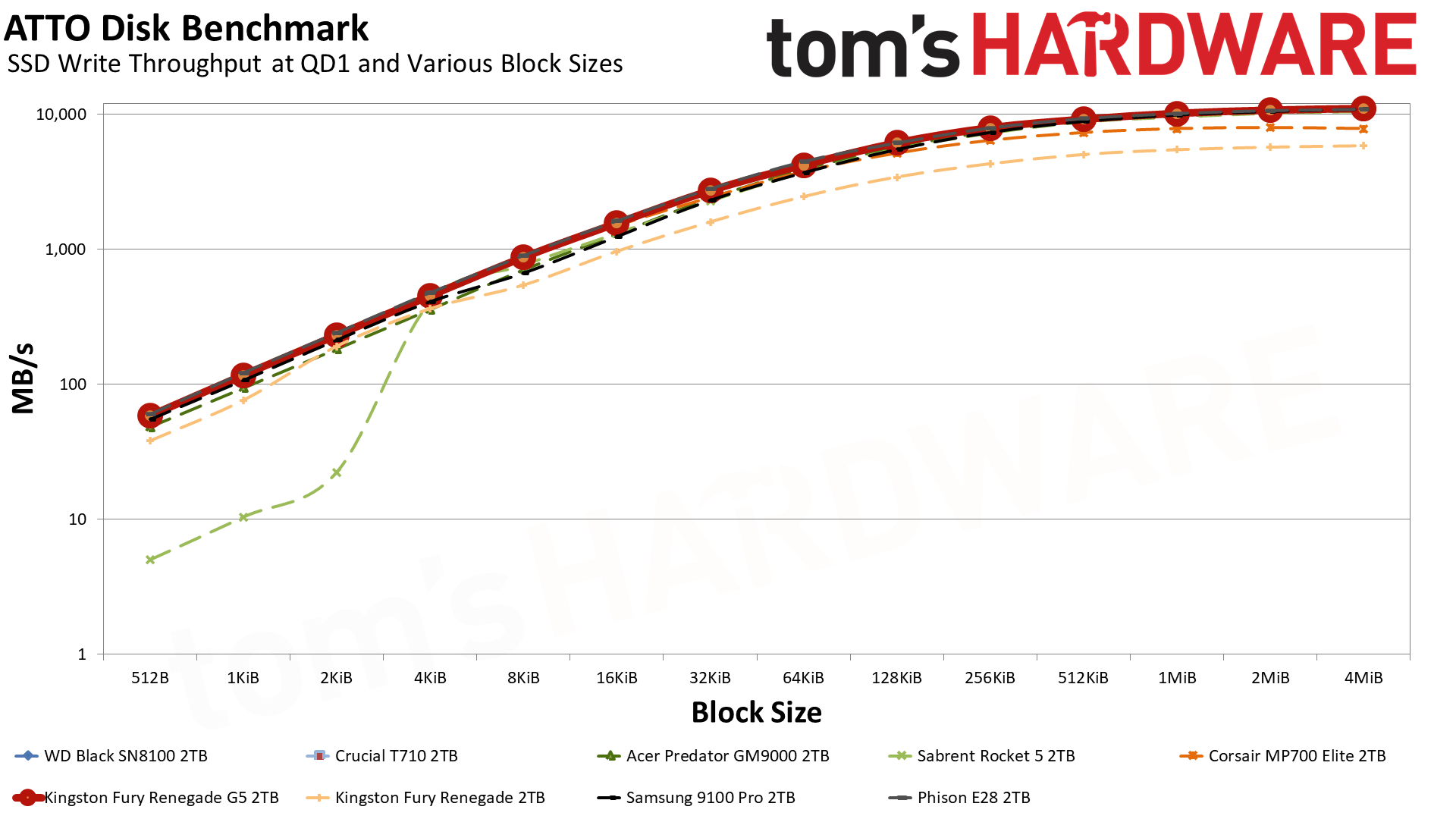
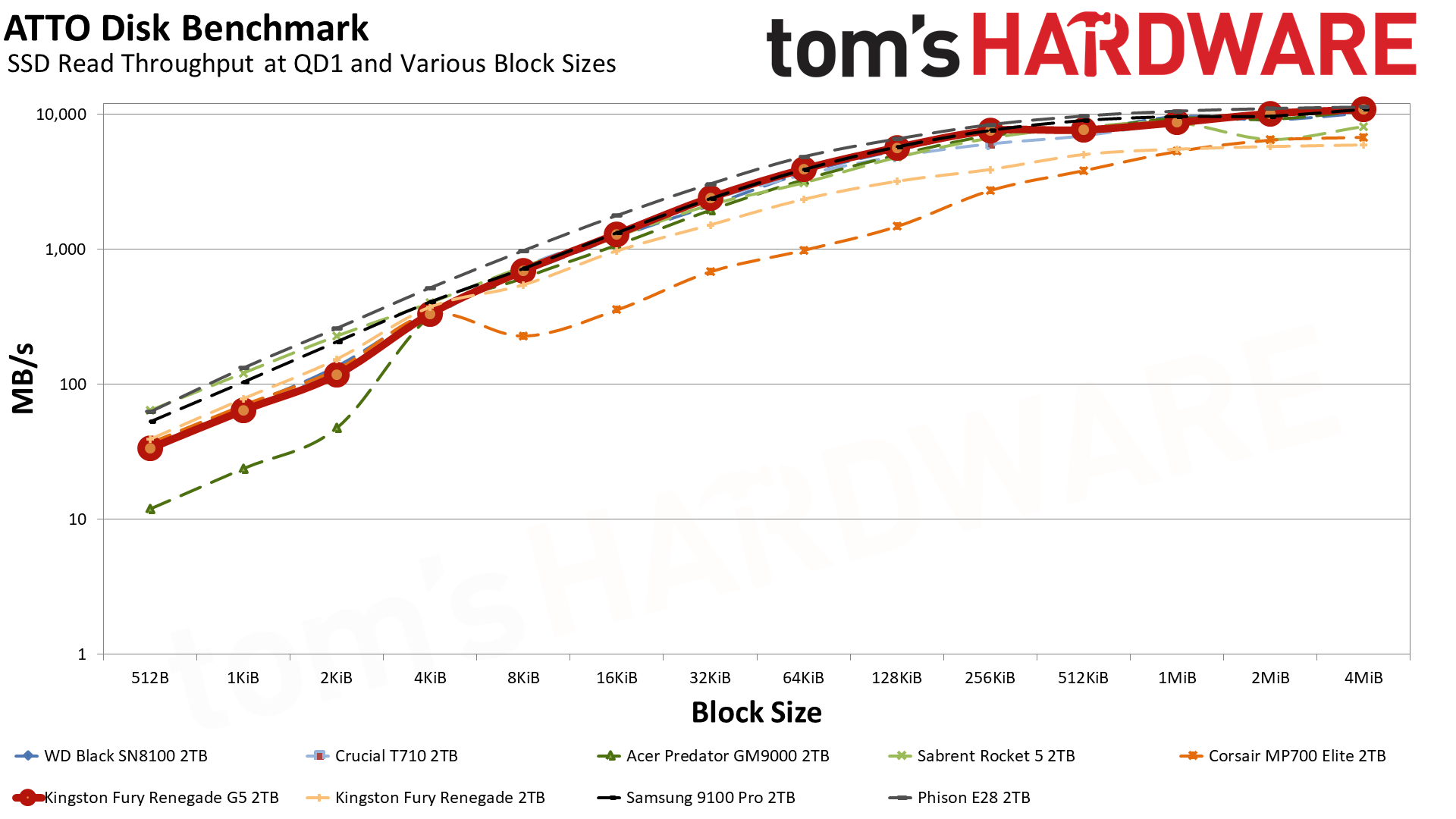
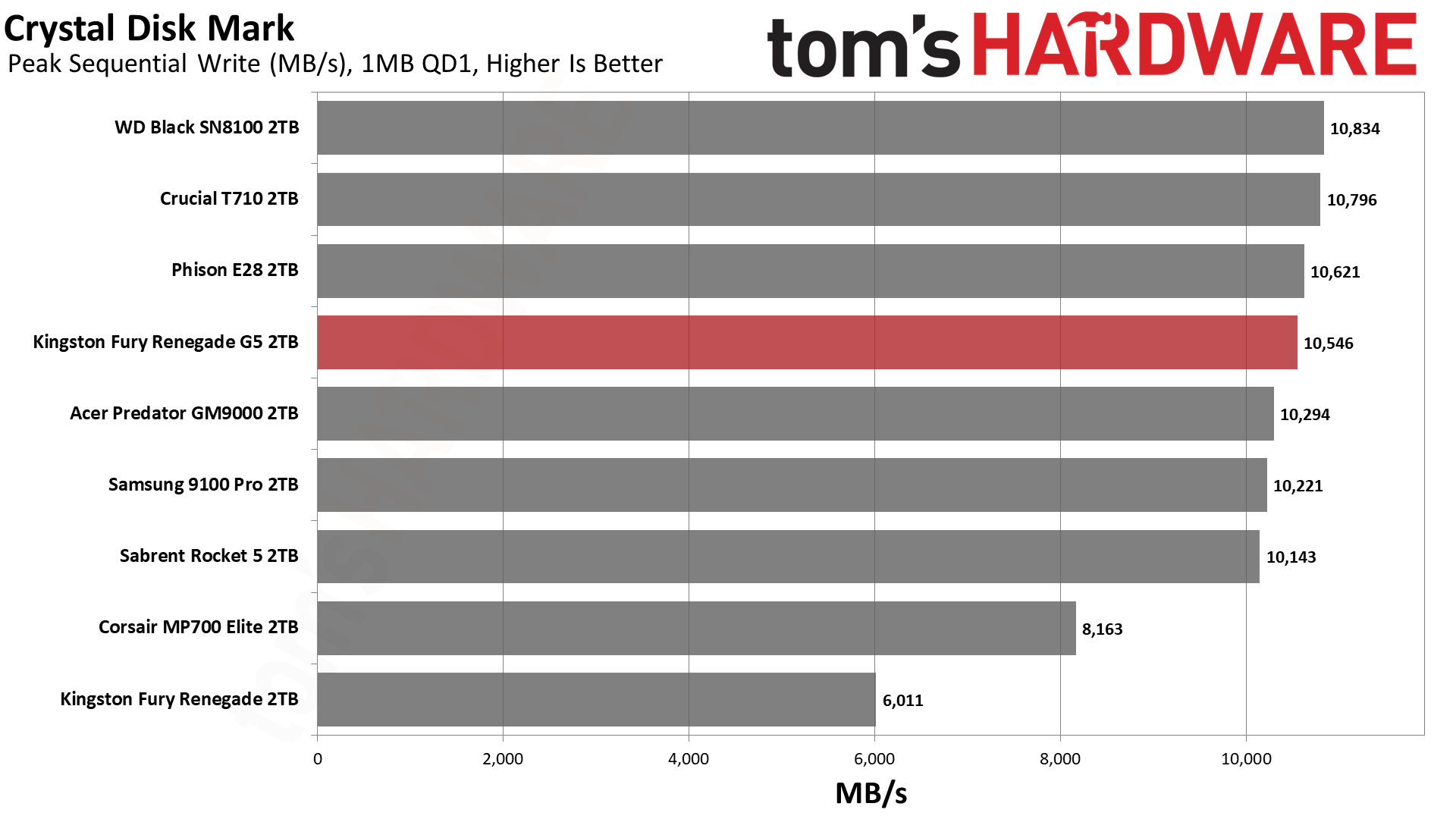
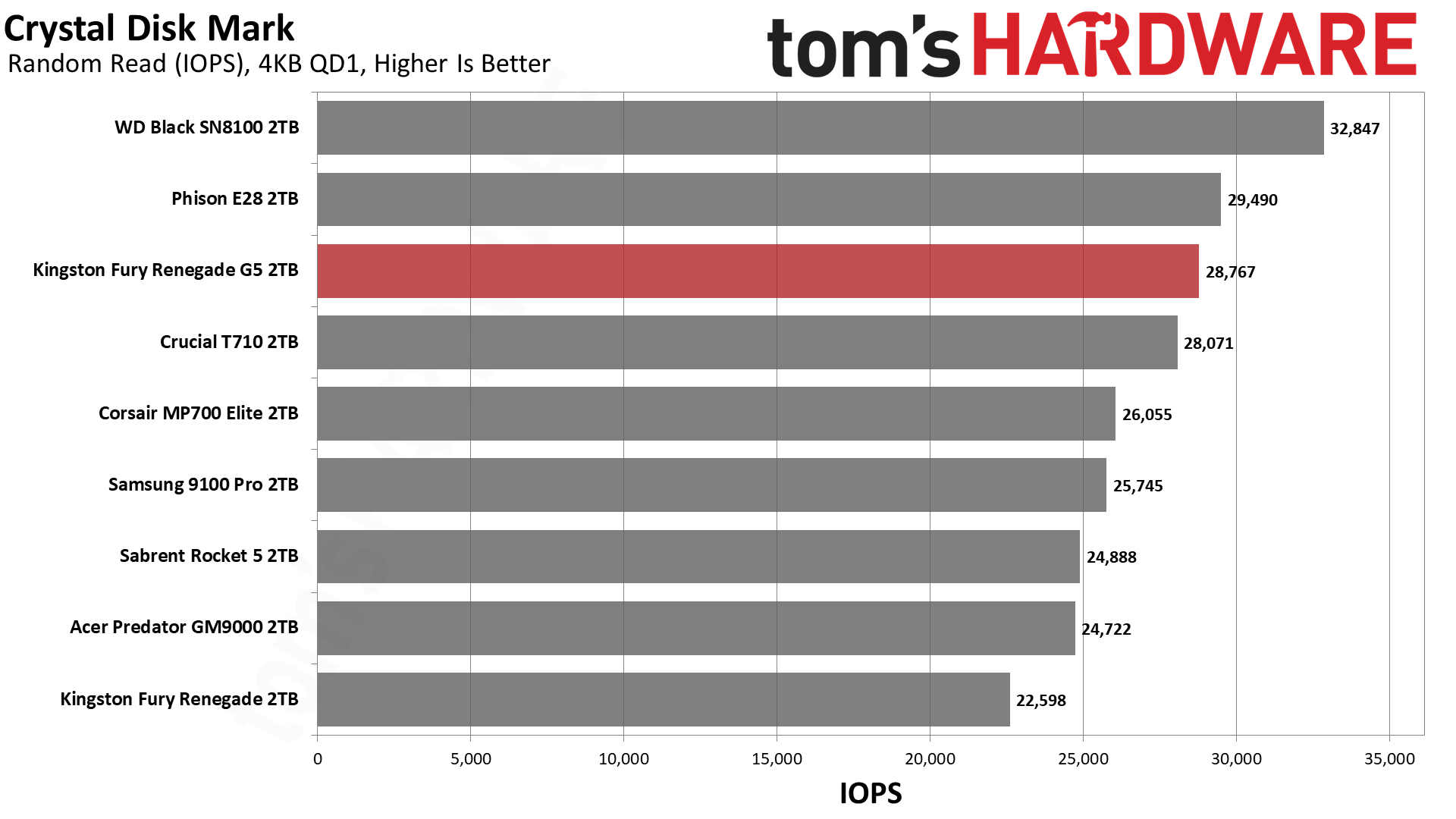
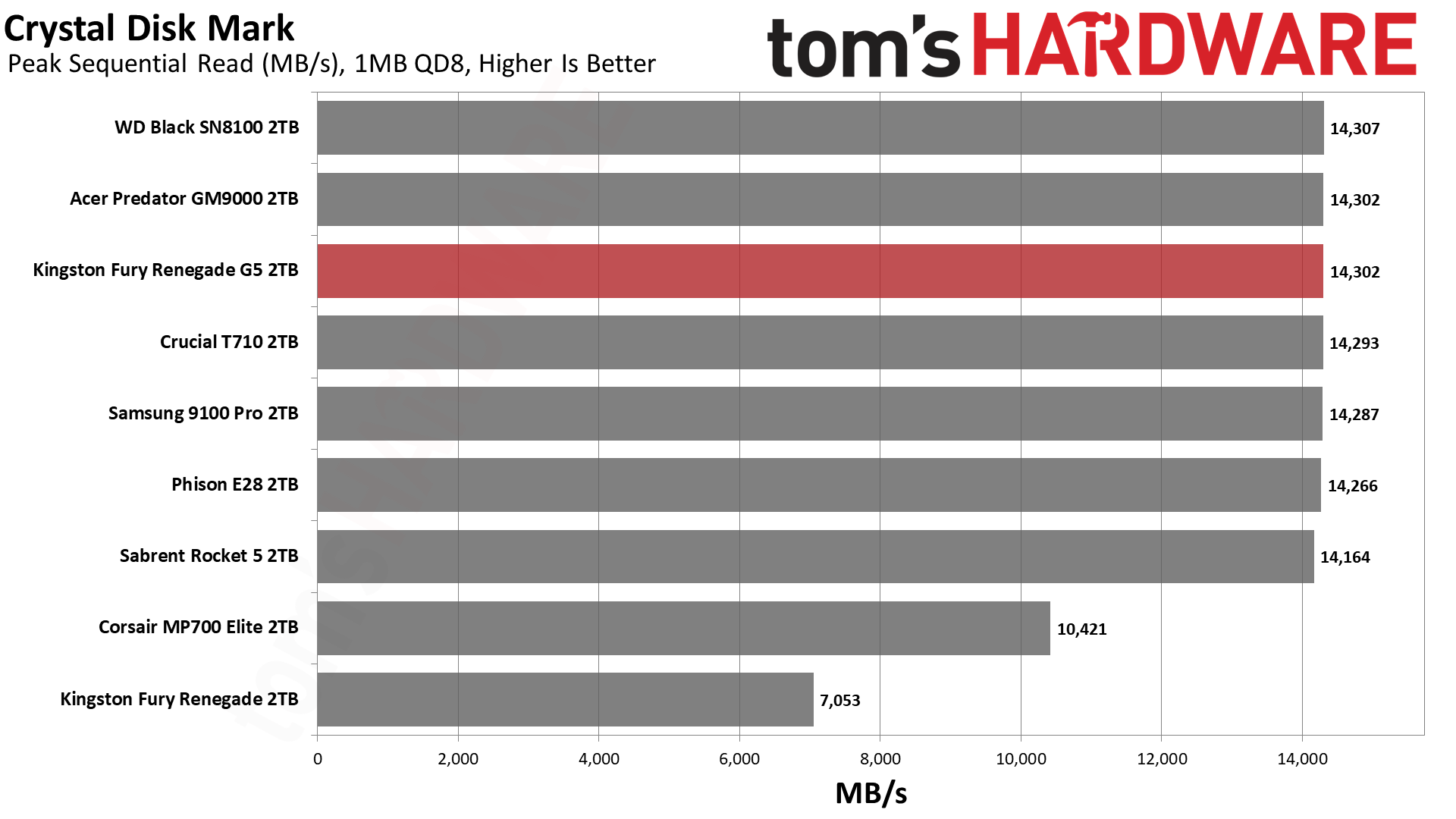
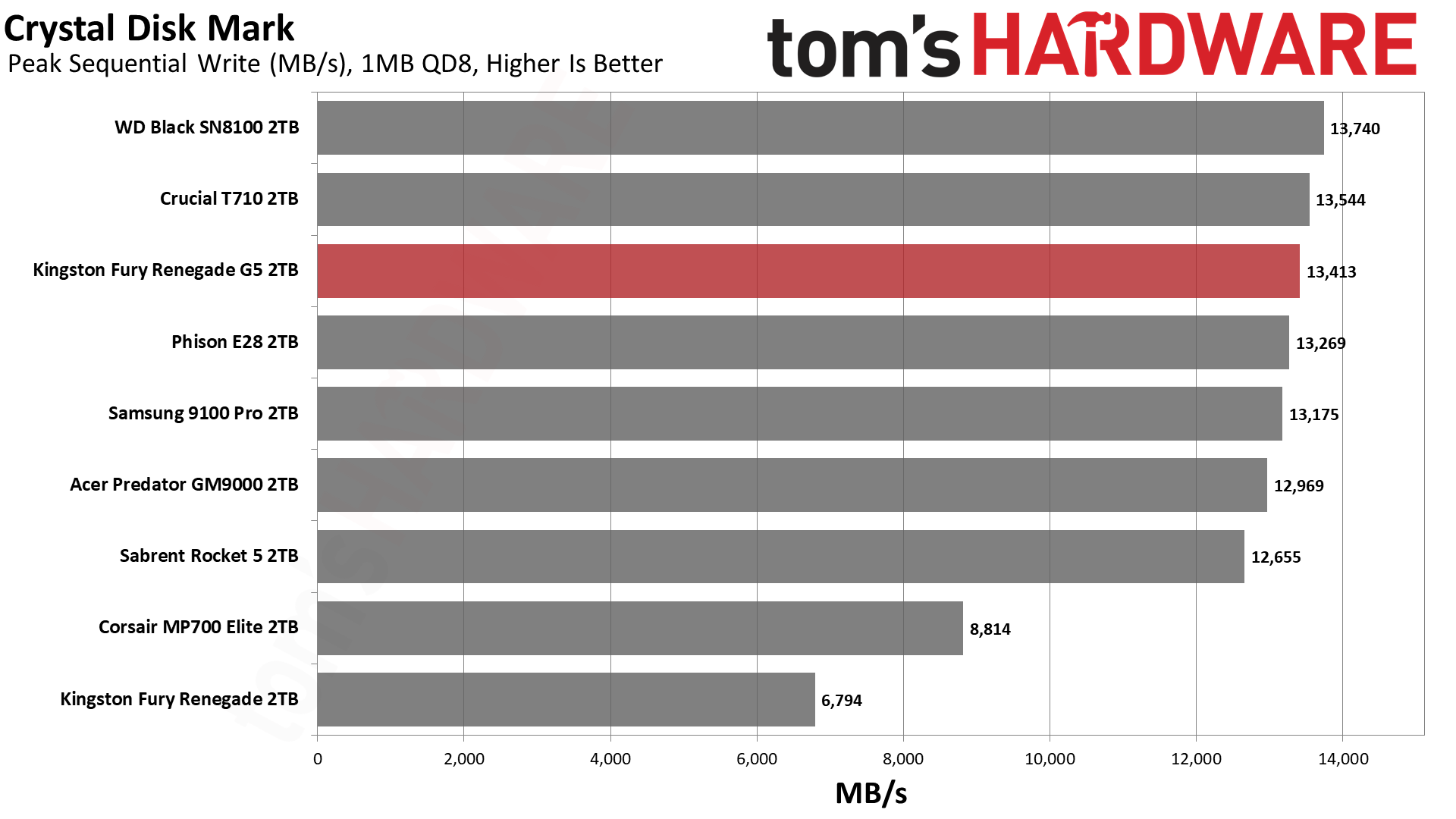
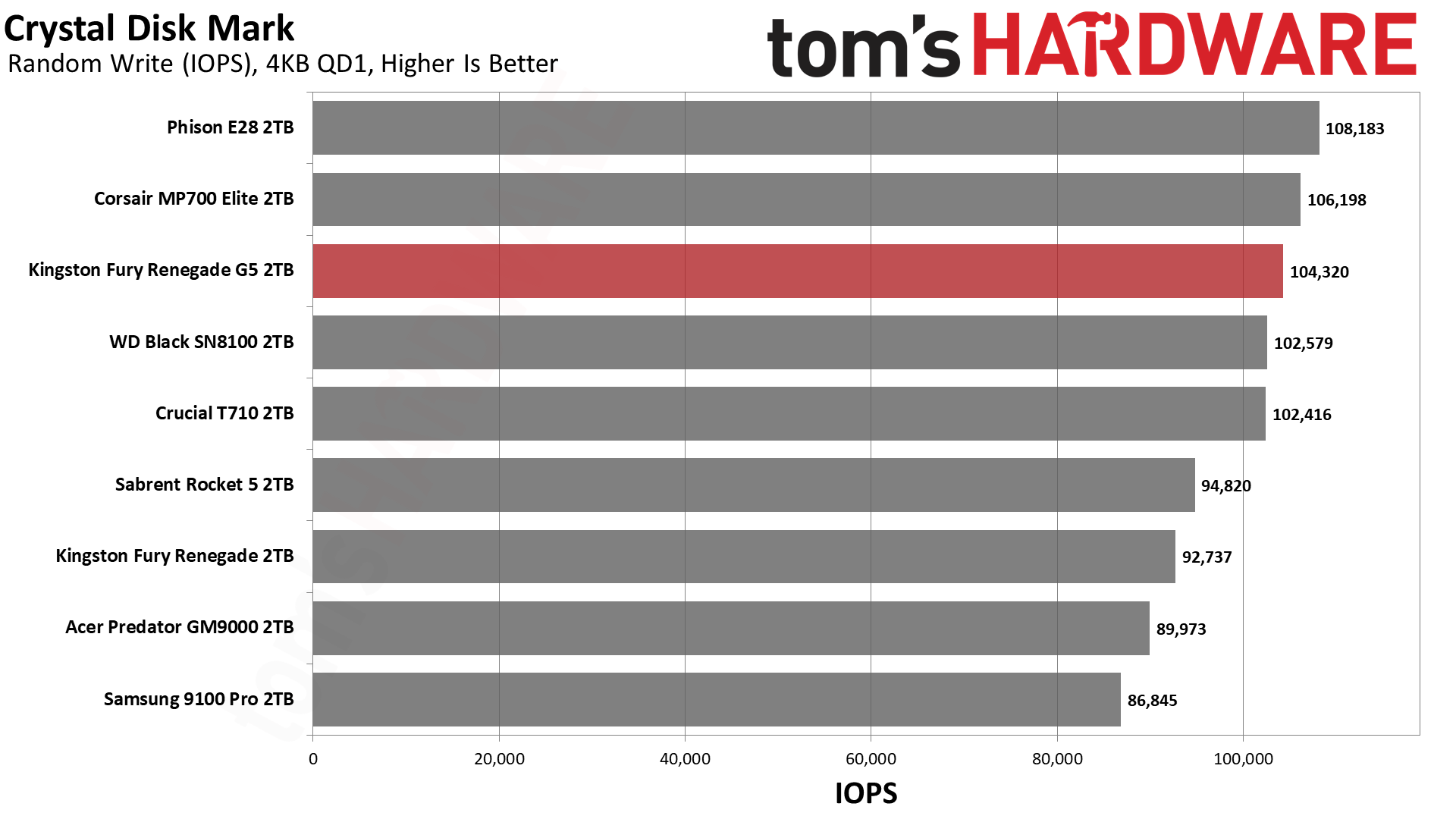
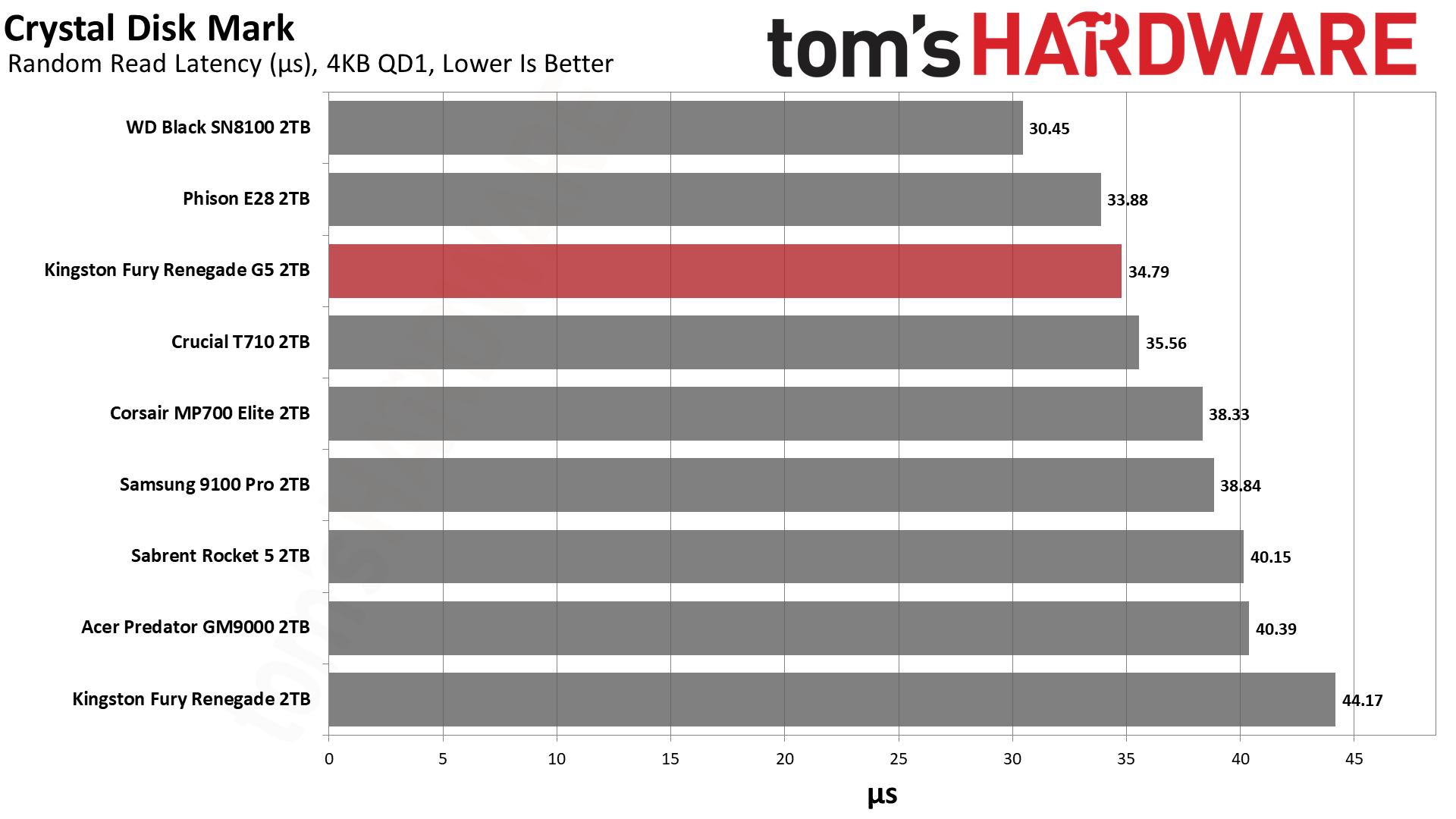
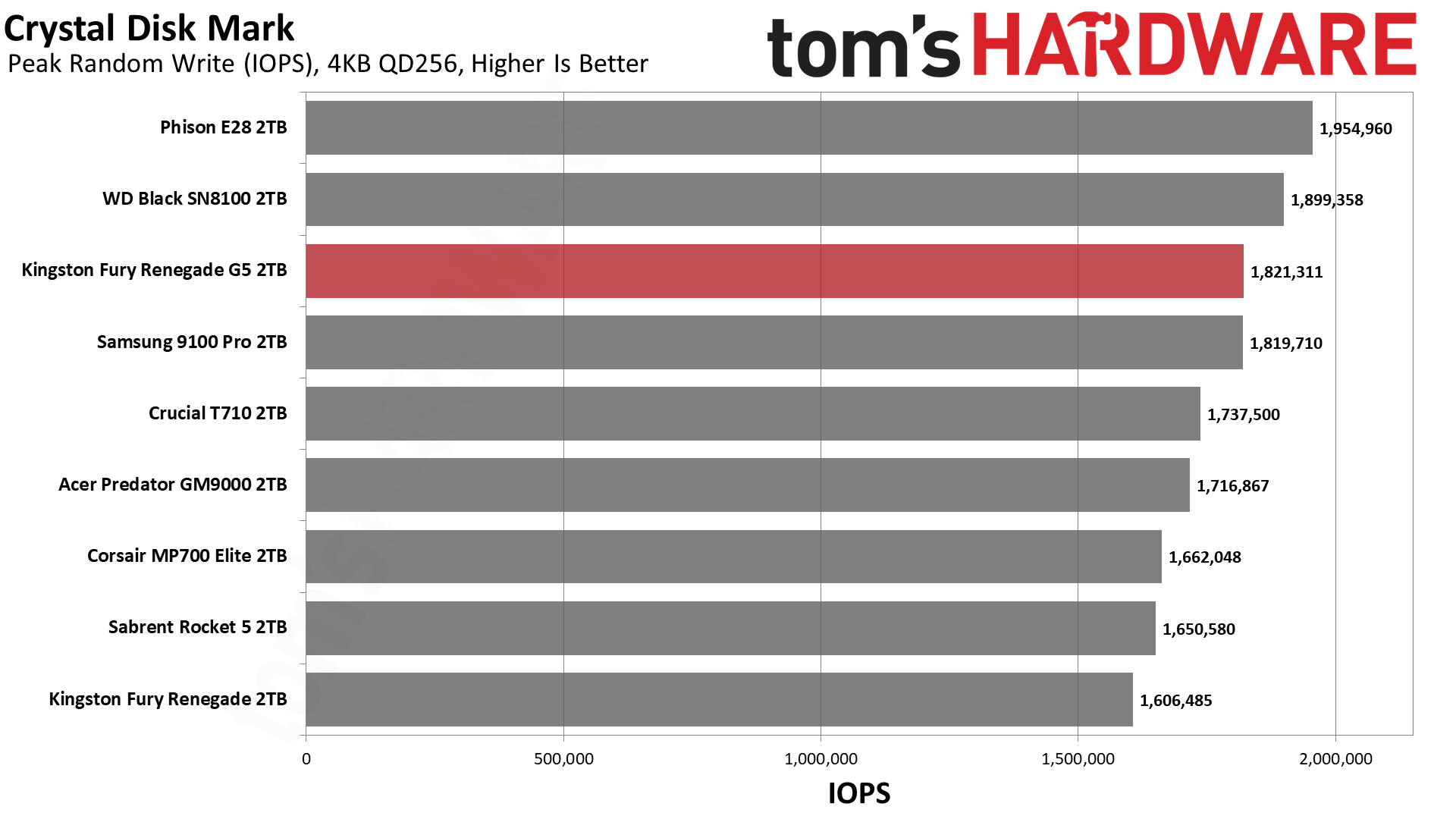
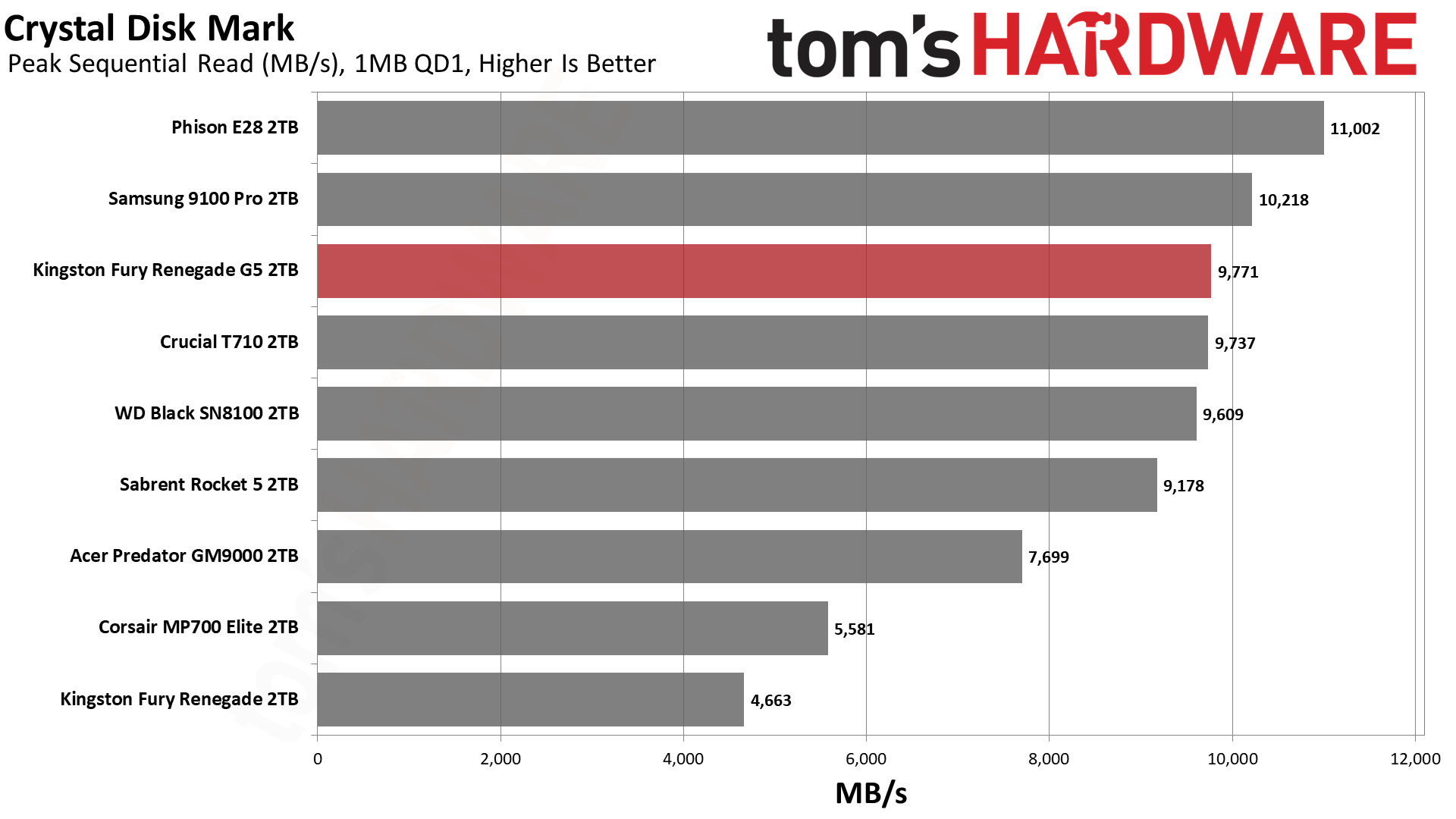
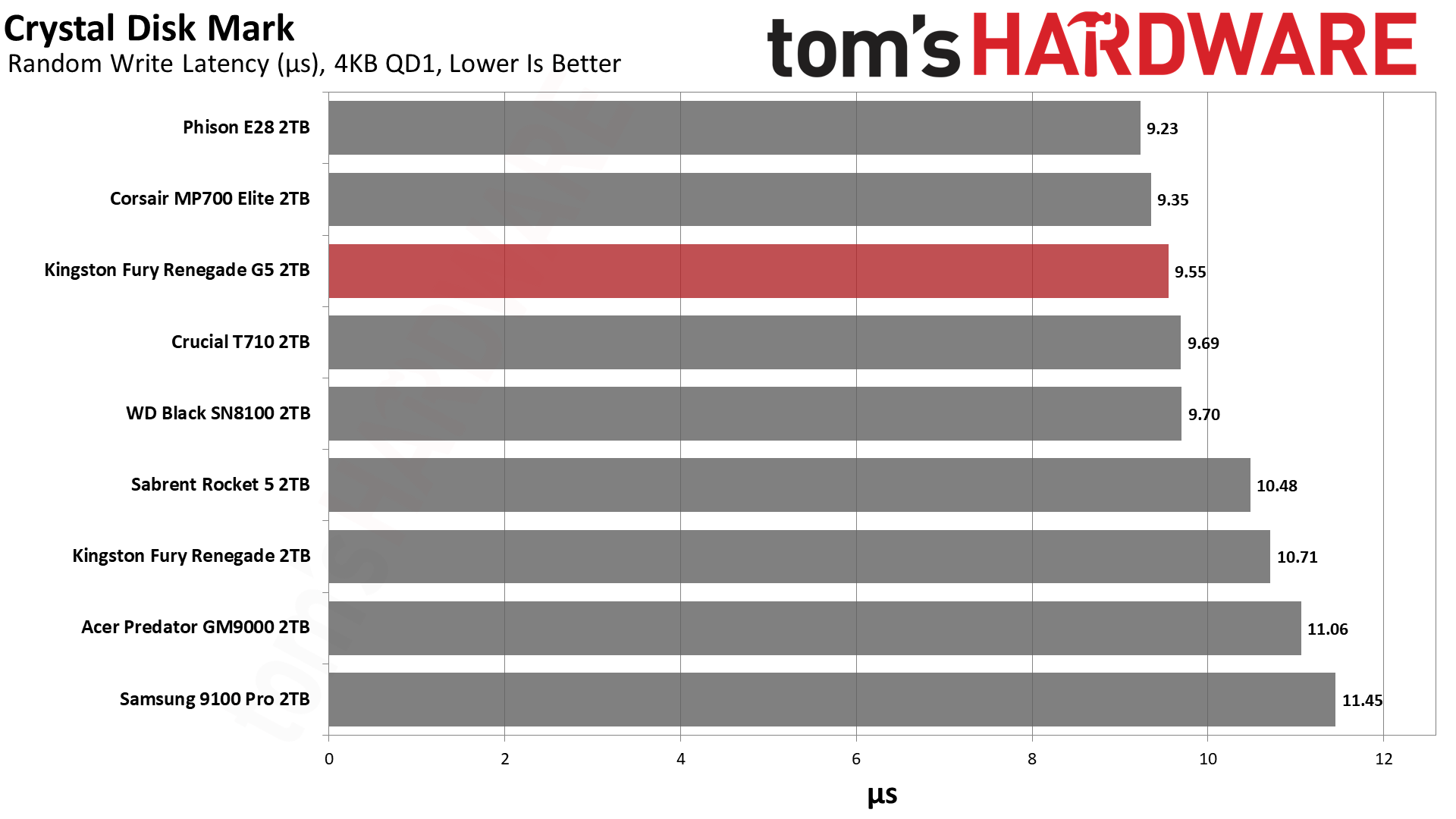
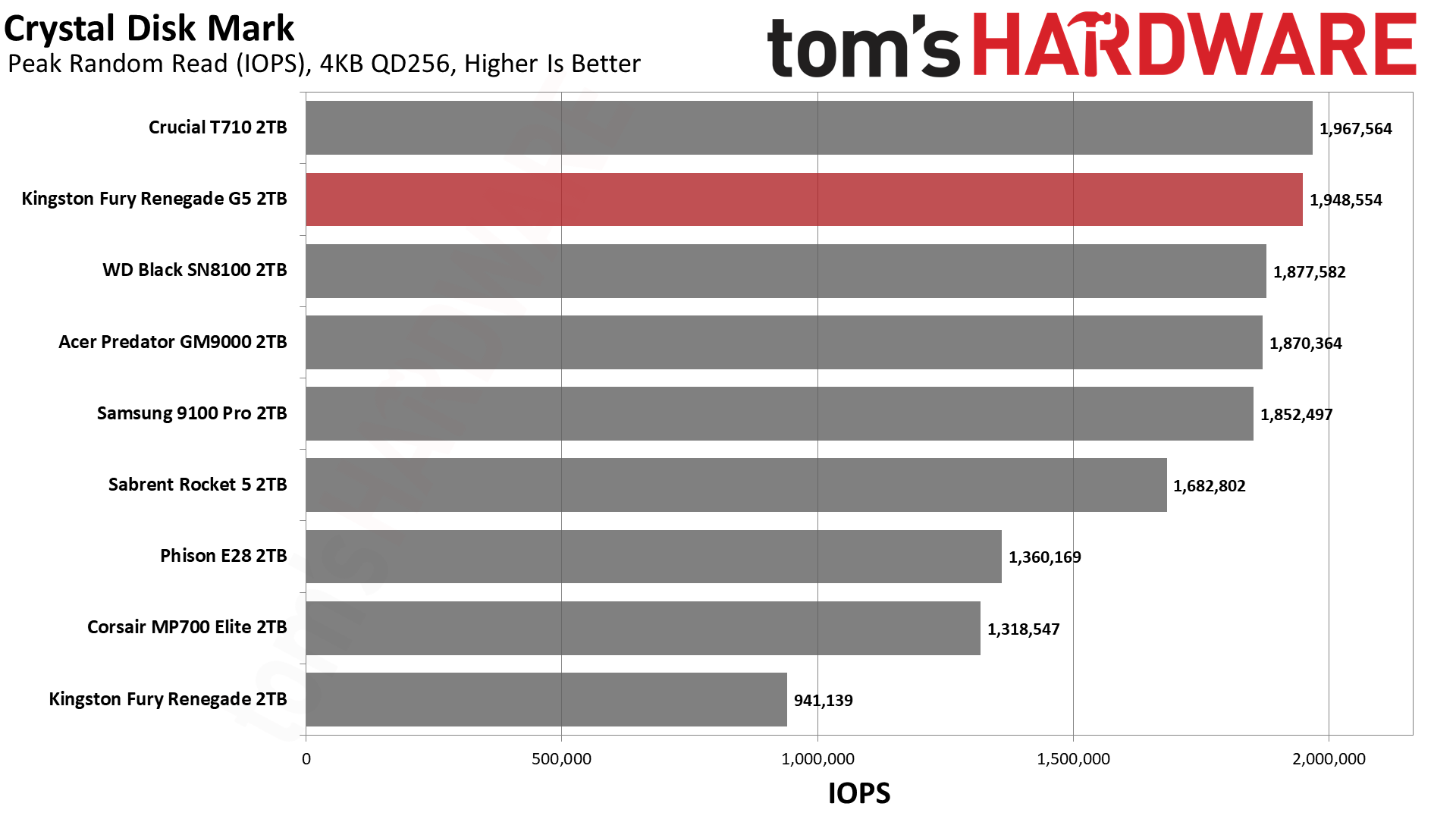
We would want and expect the Fury Renegade G5 to follow the Black SN8100 closely in ATTO. For the most part, it does, with some minor variations at larger block sizes for reads. The Phison E28 prototype, for its part, stands out with fantastic read performance in this test. We reiterate that Phison really wants to win in that arena, as most consumer workloads are read-heavy at a low queue depth. We would expect retail drives based on the E28 to be the fastest drives around, but that also means they will probably have a higher price tag. This is another area where we think the Black SN8100 or 9100 Pro are good enough that if they win on price, they are probably the way to go. That goes for the Fury Renegade G5, too.
If we look at reads on the logarithmic scale, we see that the GM9000 struggles at lower block sizes. It’s fine at 4KiB and up, which is realistically all that matters for consumer use. You’ll be working with the default 4KiB cluster size on Windows, and SSDs operate with 4KiB logical pages in mind. Some drives can be formatted for 4KiB sectors, too. However, we still have to point out that the drive’s weakness is that it shows a potential drawback to the “budget” SM2508 drives that are getting by with older flash. These drives ultimately make more sense at high capacities and for storage with fast transfers, so generally you won’t be dealing with smaller files. If you want the best responsiveness for your primary drive, though, it’s probably worth jumping up to the T710, Black SN8100, 9100 Pro, Fury Renegade G5, or E28-based drives.
CrystalDiskMark paints a better picture of the raw differences in sequential performance. Real-world transfers are often at QD1, and again, Phison is pushing the E28 to dominate here with reads. The 9100 Pro has a good showing, too. You again suffer for going with the GM9000. Lower-end PCIe 5.0 drives and any PCIe 4.0 drive will fall further behind. Once you have enough queue depth, though, the differences between the high-end PCIe 5.0 drives disappear. Gaps for sequential writes are less significant, but again, the PCIe 4.0 Fury Renegade stands no chance with the PCIe 4.0 interface limitation.
BiCS8 TLC flash is the current champion for random read latency for 4KiB transfers at QD1. Enthusiasts often look at this result to get an idea of drive responsiveness. The high-end PCIe 5.0 drives with that flash – the Black SN8100, Phison E28 ES, and Fury Renegade G5 – come out on top. The T710 is close enough that you aren’t giving up much by picking it over other drives, except for maybe the Black SN8100, which has unique optimizations. The BiCS8 flash also does great with QD1 4K write latency with the E28 ES, MP700 Elite, and Fury Renegade G5 at the top, and the SN8100 not far behind. The T710 is effectively in that class, too.
We mentioned previously that the BiCS8 four-plane design can give it an edge with latency. This is also true of a lot of QLC flash we’ve seen, which has been kept four-plane with optimizations to improve 4KiB performance and reads, especially. The media or flash remains a hard limit for potential performance improvements, but there are techniques that can improve access time. For instance, since flash is often written in a superpage — across all planes of a die at a similar offset — with some type of locality, meaning data that share characteristics are organized in a logical way, addressing can be simplified to improve multi-plane read operations.
Reads don’t require acknowledgement like writes do, either, so the read command sequence can be streamlined to further reduce latency. One potential source of higher read latency is errors, which are more prone to occur with modern multi-bit flash and QLC specifically. However, the controller can intelligently and proactively adjust voltage thresholds before reading to avoid a read retry. Read recovery and reads that interrupt program cycles can also be handled intelligently, to name only a few general areas of potential improvement, while ignoring writes. Managing this on the controller and flash level gets more complicated as density and plane count increase.
Six-plane QLC flash is on the way, which is expected because we’ve had six-plane TLC flash for a while, and QLC needs to keep up in both density and throughput. More planes mean more complexity for optimization. These improvements may come to QLC first in part because the relative gain is higher, but also because QLC demand is rising in the enterprise. We’re translating lessons learned from QLC flash to TLC flash. That’s relevant to any PCIe 5.0 SSD discussion because there really are differences between the Kioxia and Micron flash that you should be aware of when picking a high-end drive. This gap melts away a bit at 8TB because Samsung is also using four-plane flash and the 8TB Black SN8100 will, too, not to mention the fact that the E28 is using four-plane BiCS8 so far as well. At lower capacities, though, this decision can impact the performance profile of the drive, making the T710 potentially better at 1TB. Another potential trade-off would be cost which is dependent on many factors including yield. For the end user this could translate to some savings, but it’s up to you to decide if it’s worth it.
Sustained Write Performance and Cache Recovery
Official write specifications are only part of the performance picture. Most SSDs implement a write cache, which is a fast area of pseudo-SLC (single-bit) programmed flash that absorbs incoming data. Sustained write speeds can suffer tremendously once the workload spills outside of the cache and into the "native" TLC (three-bit) or QLC (four-bit) flash. Performance can suffer even more if the drive is forced to fold, which is the process of migrating data out of the cache in order to free up space for further incoming data.
We use Iometer to hammer the SSD with sequential writes for 15 minutes to measure both the size of the write cache and performance after the cache is saturated. We also monitor cache recovery via multiple idle rounds. This process shows the performance of the drive in various states as well as the steady state write performance.
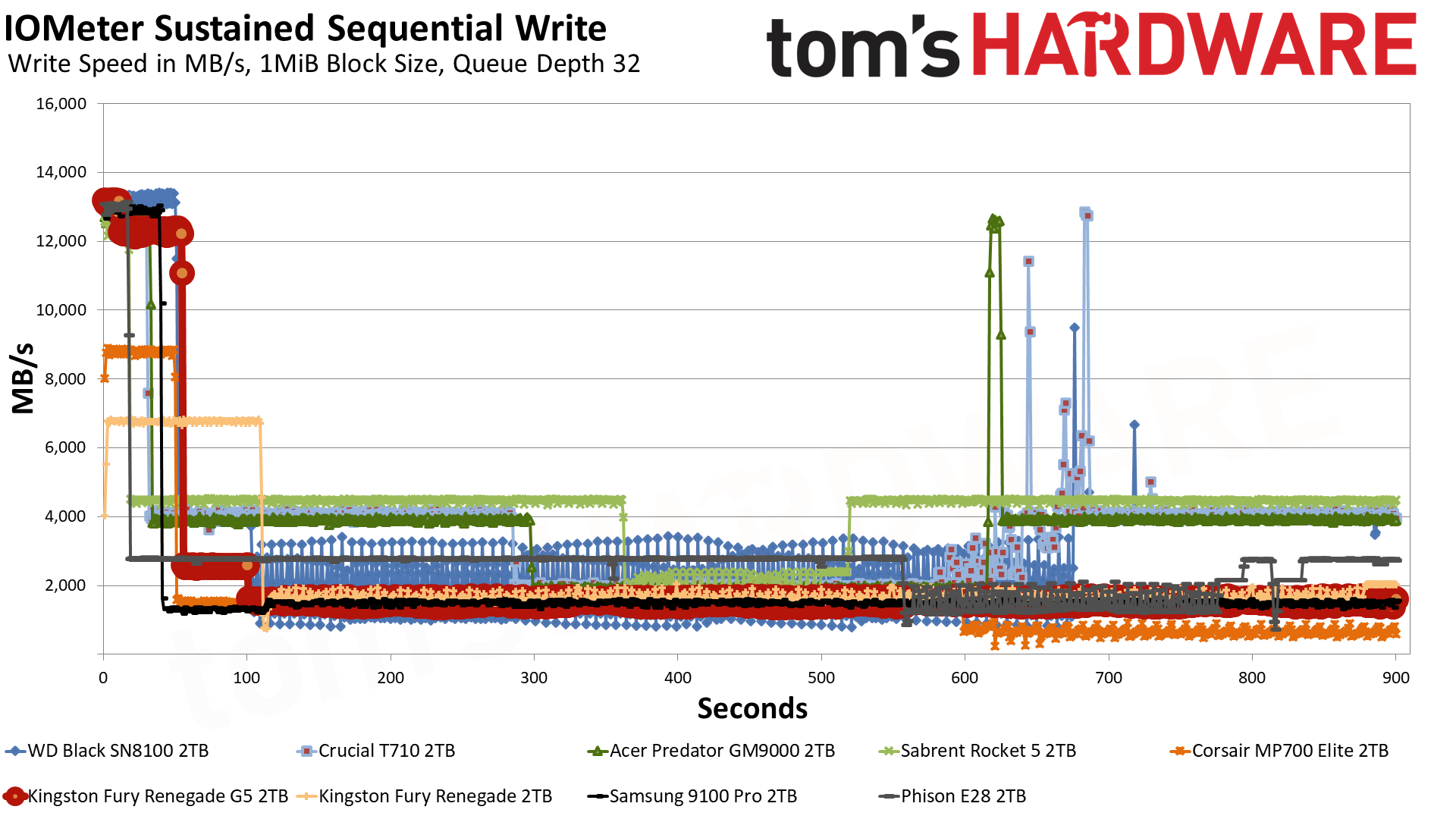
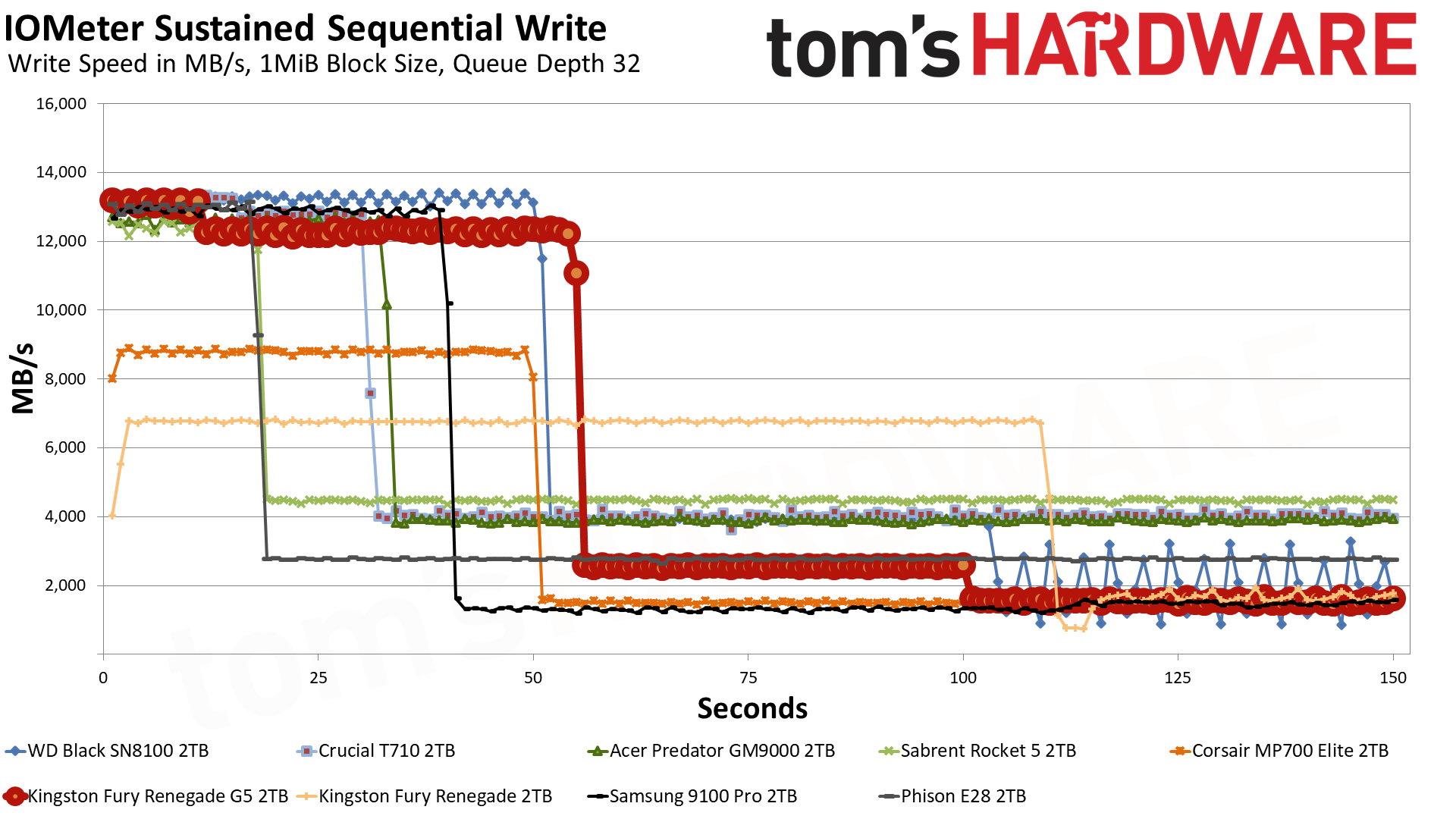
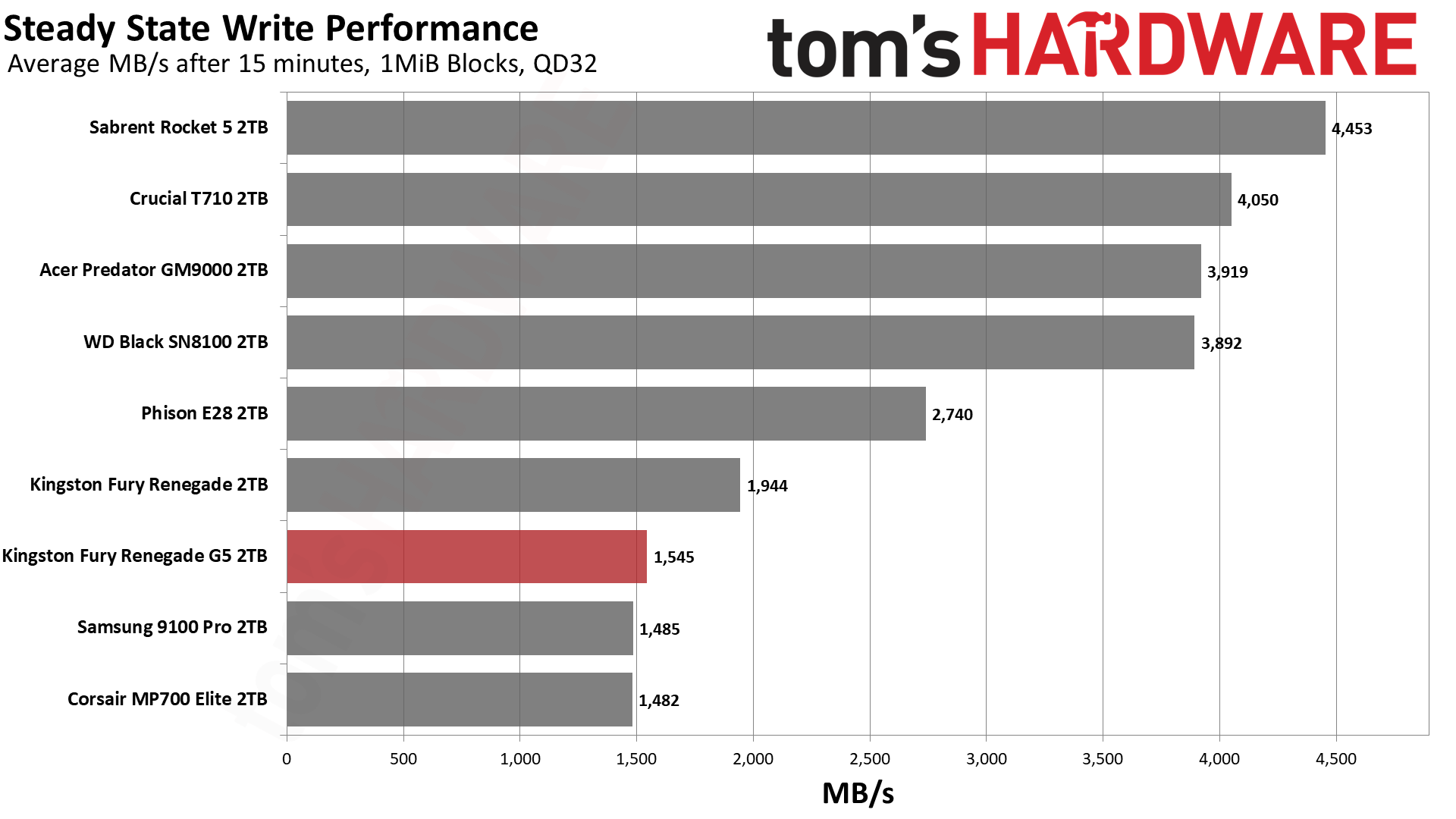
The Kingston Fury Renegade G5 has a somewhat unusual write profile, starting off by writing at 13.1 GB/s for just 11 seconds. This is in the temporary cache mode and resembles some of the static pSLC responses we’ve seen in the past. Static pSLC is taken out of non-user flash, so it is limited in size but always available, which means it usually has high endurance. While older drives like the WD Black SN750 only had static cache, drives today have dynamic cache that can be much larger, either alone or in tandem with static cache. WD’s/SanDisk’s nCache and Samsung’s TurboWrite are examples of caching systems with both static and dynamic. We know that the Fury Renegade G5 doesn’t really have static here because that first mode is far too large, and further, static pSLC is often slower than dynamic because the higher-endurance wordlines often used for it have the trade-off of slower programming time due to how dies are etched.
Why do we bring that up? Well, we have seen a cache response like this before on Maxio MAP1602-based drives, such as the recently reviewed Acer FA200. We posited in that and previous reviews that this early burst of speed can be static-like as a way to handle smaller random writes from the host/user. We also know this tends to be controller-specific rather than flash-specific because here we see the T710 follows the Fury Renegade G5’s pattern. This is interesting because it suggests extra optimization is present to improve the user experience. This will likely continue with newer hardware as time goes on, providing an additional, if minor, reason to upgrade.
The 2TB Fury Renegade G5 continues to write for another 43 seconds in pSLC at 12.3 GB/s for a 670GB cache. This is about as big as the cache can be when converting 2TB of 3-bit TLC flash into a 1-bit pSLC mode. This is very aggressive, which some users might like and others maybe not so much. It means incredible burst write performance, which is particularly nice with a fast PCIe 5.0 drive. However, it also means that sustained write performance will suffer.
The drive hits a TLC mode after this, writing at 2.56 GB/s for 45 seconds. This is reasonably fast, but we know it can do better, with 4 GB/s not being impossible. However, because this drive has such a large cache, it is limited in what it can do. It’s trying to balance writing directly to the native TLC flash with evacuation of the pSLC cache to TLC. Eventually, this becomes untenable because the drive needs more space to handle incoming data, and the drive is forced to wait for data migration. This folding mode has writes averaging around 1.545 GB/s. This isn’t bad and matches the 9100 Pro, but we’ve seen better things from the SN8100 and T710. The Rocket 5 is the fastest drive we’ve seen here, even with its older hardware, and in fact, even the original Fury Renegade can muster more performance. Again, this is due to the manufacturer's decision to emphasize peak and burst write performance.
Power Consumption and Temperature
We use the Quarch HD Programmable Power Module to gain a deeper understanding of power characteristics. Idle power consumption is an important aspect to consider, especially if you're looking for a laptop upgrade as even the best ultrabooks can have mediocre stock storage. Desktops may be more performance-oriented with less support for power-saving features, so we show the worst-case.
Some SSDs can consume watts of power at idle while better-suited ones sip just milliwatts. Average workload power consumption and max consumption are two other aspects of power consumption but performance-per-watt, or efficiency, is more important. A drive might consume more power during any given workload, but accomplishing a task faster allows the drive to drop into an idle state more quickly, ultimately saving energy.
For temperature recording we currently poll the drive’s primary composite sensor during testing with a ~22°C ambient. Our testing is rigorous enough to heat the drive to a realistic ceiling temperature.
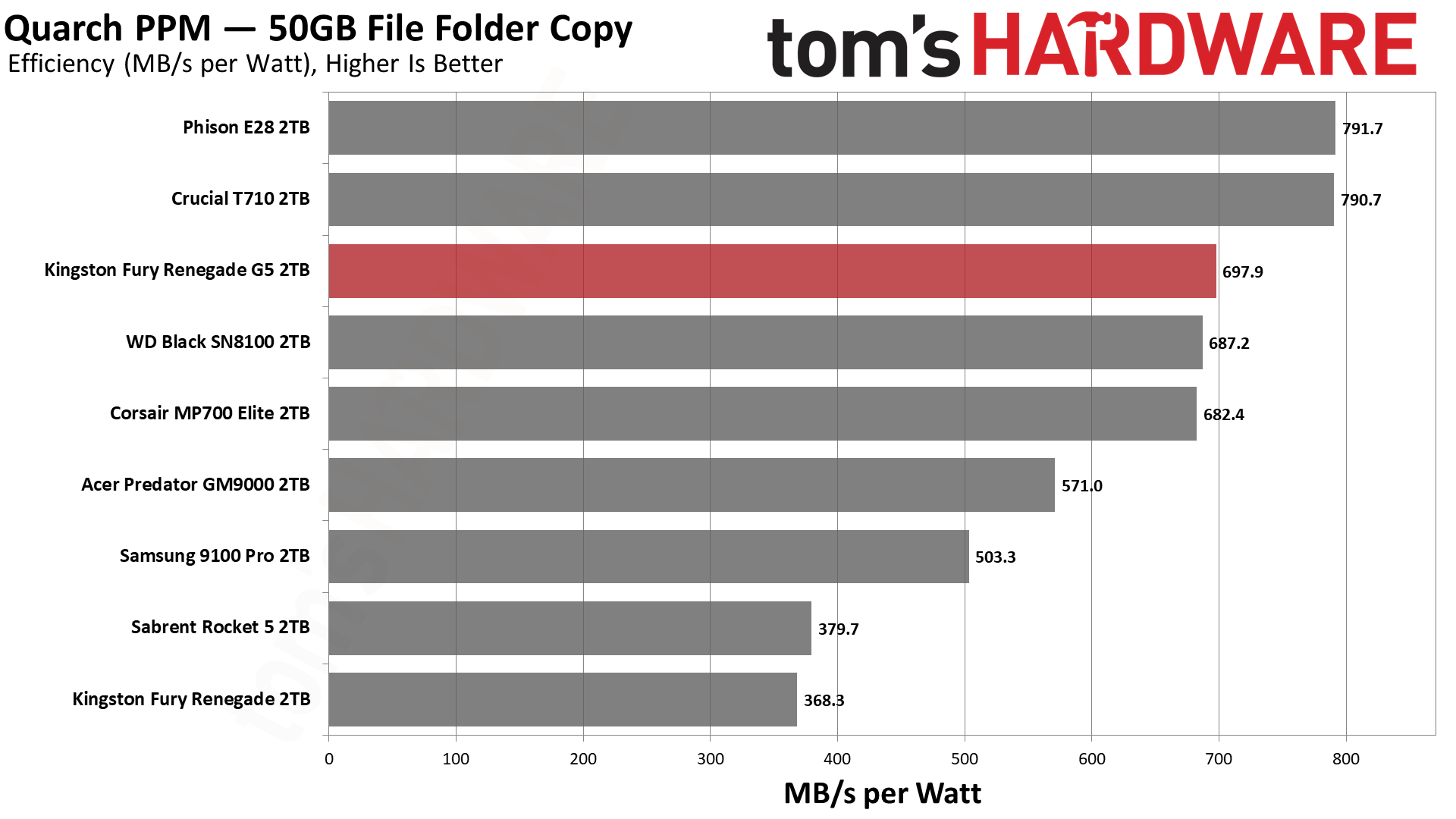
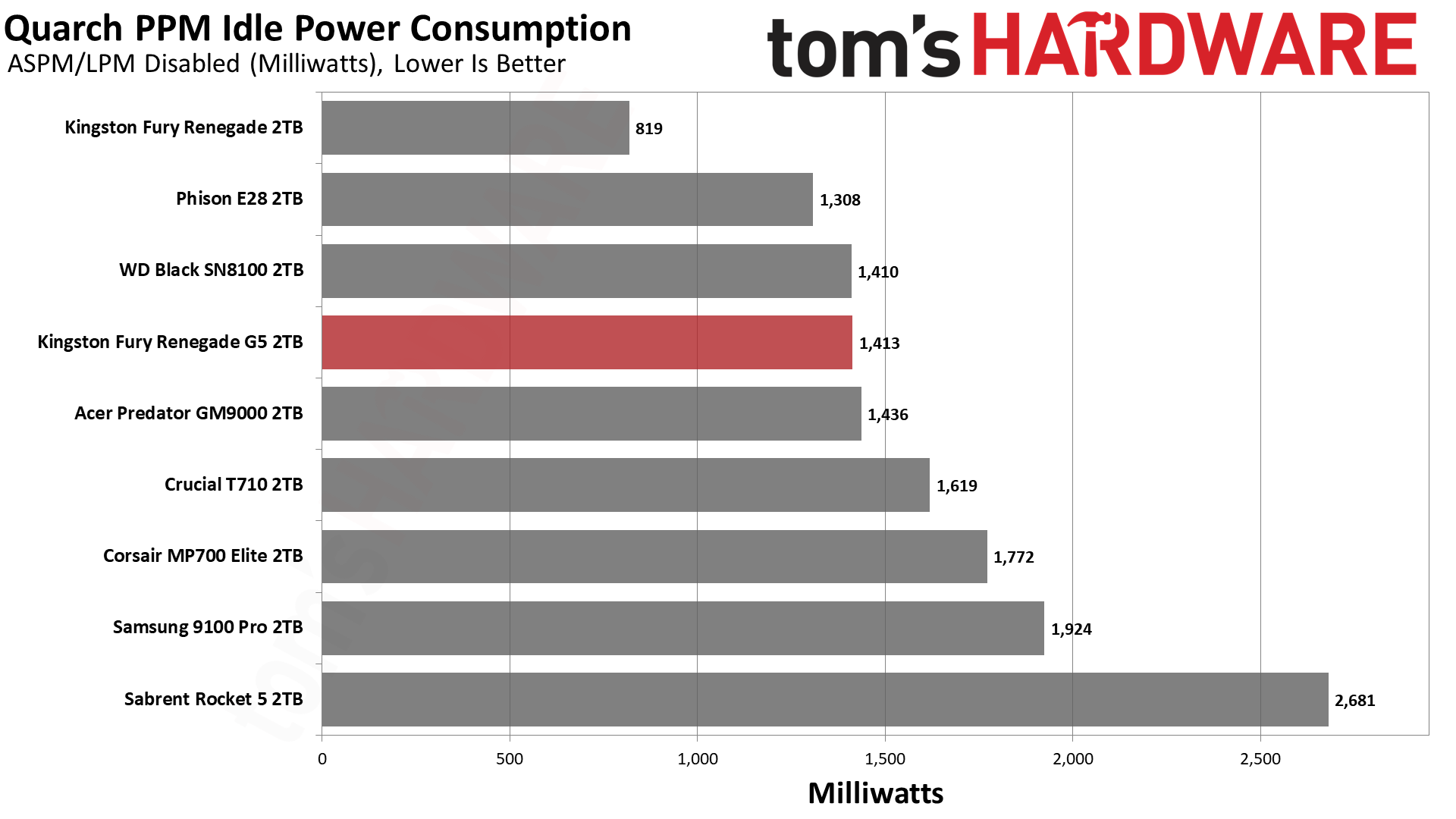
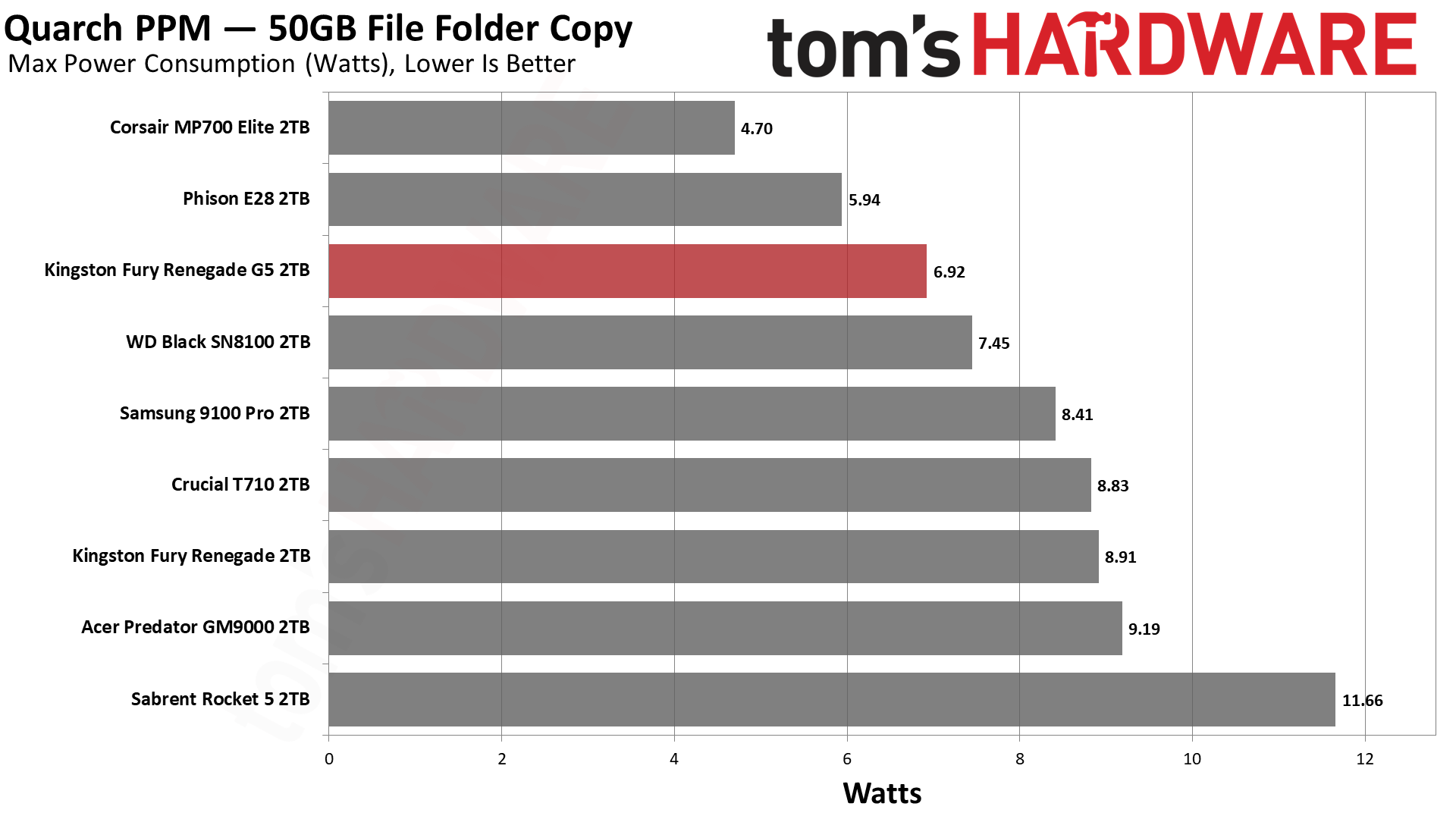
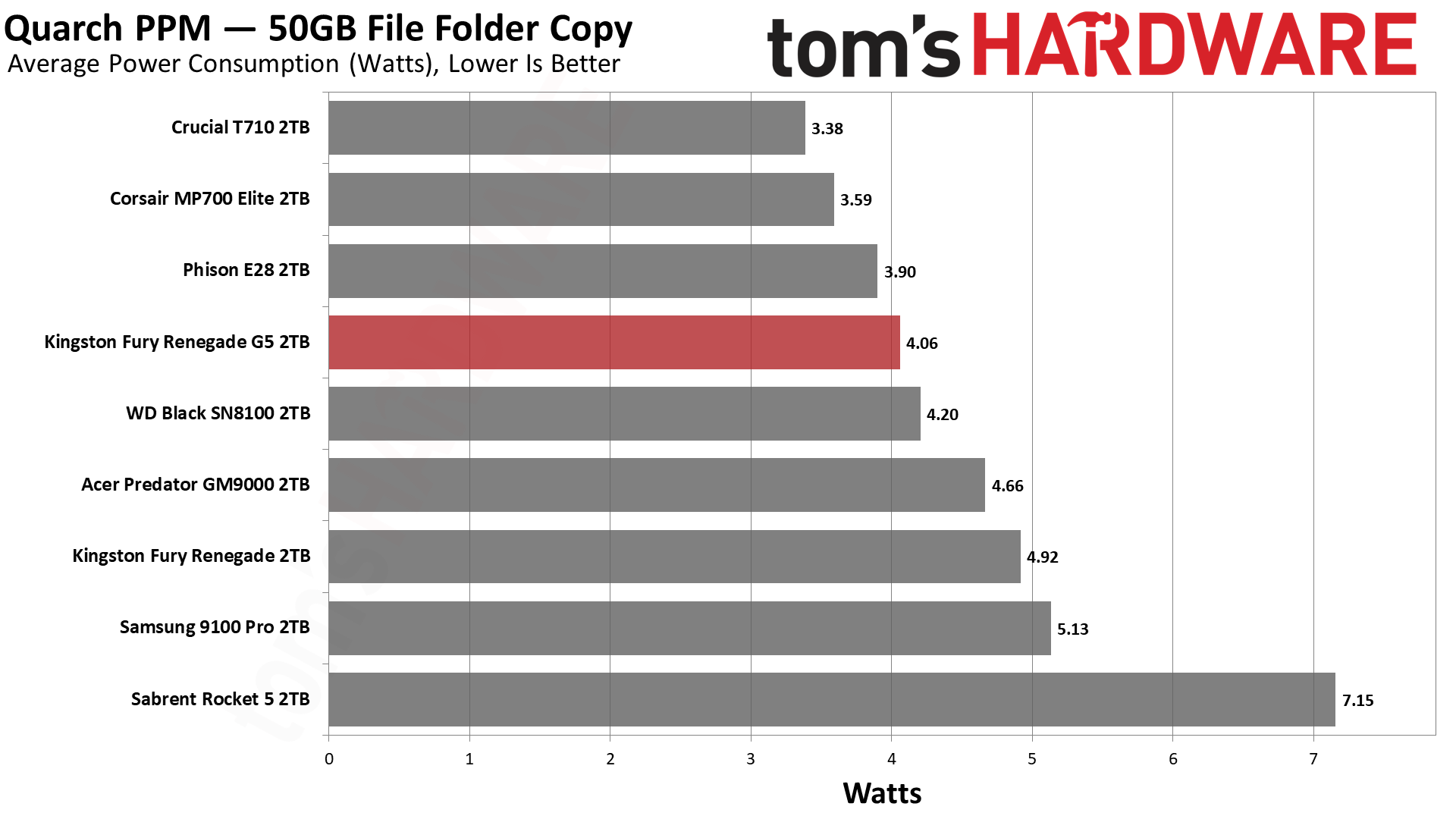
We’ve come to expect almost crazy levels of power efficiency with newer drives and the Fury Renegade G5 doesn’t disappoint. It’s very close to the SN8100 and MP700 Elite. The E28 might end up better, but we’ll have to check retail drives to be sure. It’s not too relevant because, frankly, the Fury Renegade G5 is efficient enough to be used in laptops and HTPCs with just the heatspreading label. Our main point of caution is that the drive is rated for 9W peak, but this really only applies to the 4TB SKU. If your intention is to get it at 4TB for a laptop, adding some additional cooling – like a low-profile heatsink or thermal padding – might be wise if you use the laptop for heavier work.
The drive only reached 52°C during our testing, which is very cool indeed. The label does help to spread heat a little. The controller will be the hottest point on this drive, so wicking away heat from its surface is sufficient to prevent throttling with good airflow.
Test Bench and Testing Notes
CPU | Row 0 - Cell 2 | |
Motherboard | Row 1 - Cell 2 | |
Memory | Row 2 - Cell 2 | |
Graphics | Intel Iris Xe UHD Graphics 770 | Row 3 - Cell 2 |
CPU Cooling | Row 4 - Cell 2 | |
Case | Row 5 - Cell 2 | |
Power Supply | Row 6 - Cell 2 | |
OS Storage | Row 7 - Cell 2 | |
Operating System | Row 8 - Cell 2 |
We use an Alder Lake platform with most background applications such as indexing, Windows updates, and anti-virus disabled in the OS to reduce run-to-run variability. Each SSD is prefilled to 50% capacity and tested as a secondary device. Unless noted, we use active cooling for all SSDs.
Kingston Fury Renegade G5 Bottom Line
We like the Kingston Fury Renegade G5. A lot. It’s a definite upgrade over the original Fury Renegade and its KC3000 sibling that just feels natural. In part, that’s because this is a no-frills, single-sided drive that performs well without acting like a space heater. Kingston has all the software angles covered and even throws in a higher-than-standard write endurance warranty. This makes the Fury Renegade G5 feel like a safe choice in a market that has so many alternatives and pretenders. Does it have the name recognition of the WD Black SN8100 or Samsung 9100 Pro? No, and you’ll have to look at those to get an 8TB drive, but anybody who has had a good experience with Kingston drives or will settle for the name – and that’s easier to do in other regions of the globe – can safely rely on it for a solid storage experience.
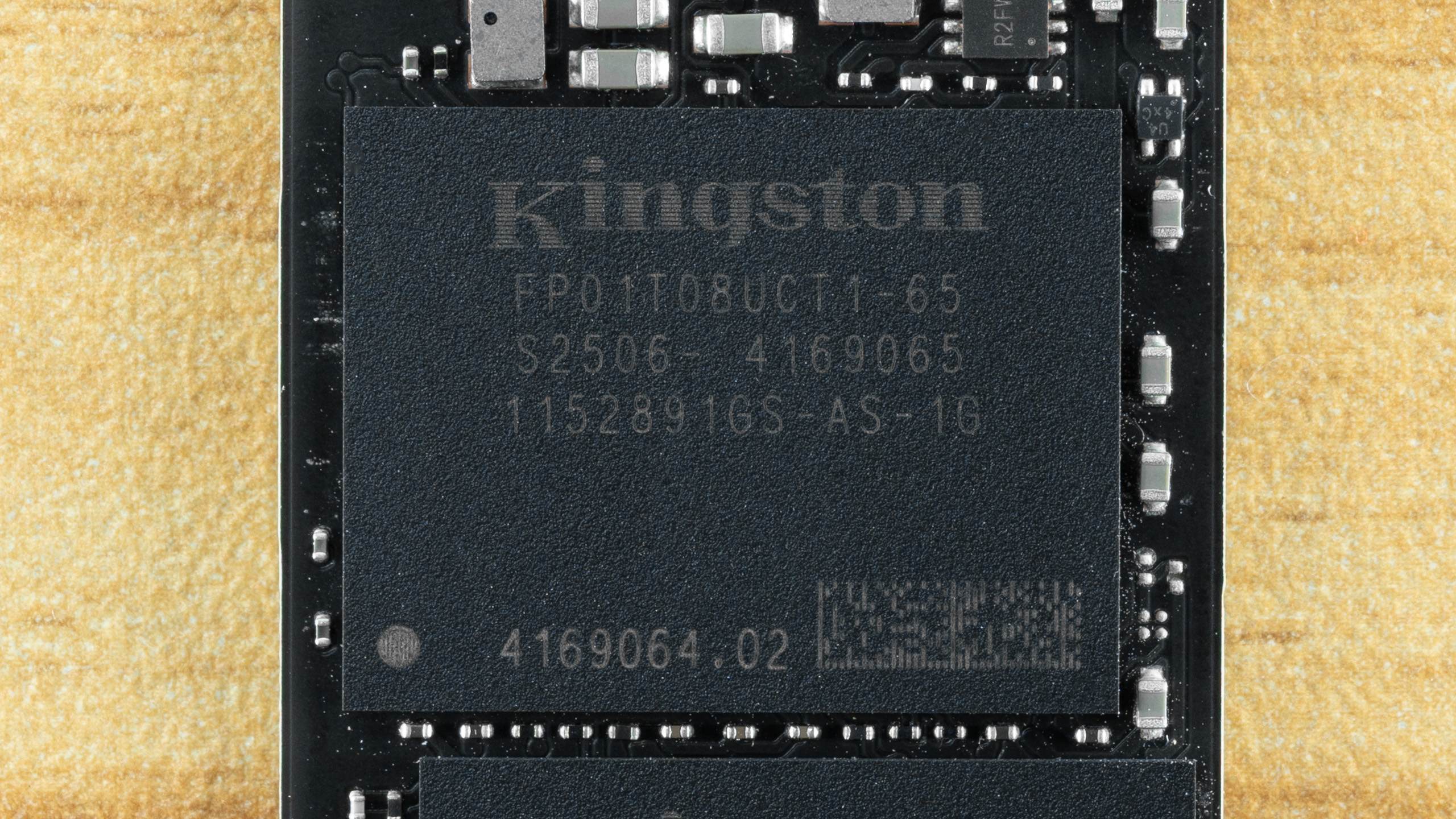
We don’t really consider lower-end drives a threat to the Fury Renegade G5. If all you want is an inexpensive games drive, a PCIe 4.0 SSD will get the job done. This one is for higher performance and faster transfers. Sure, a mid-range PCIe 5.0 drive like the MP700 Elite will run great in a laptop or in any PCIe 4.0 slot if you want power efficiency and some future-proofing, but you know deep down you’re not reaching the full potential of the PCIe 5.0 interface. Older E26-based drives, on the other hand, run very hot. Newer alternatives like the Predator GM9000 can save you some money but still make more sense as a high-end secondary drive. You simply want the goods for your daily driver. The Fury Renegade G5 can deliver.
Its real competition, aside from the aforementioned Black SN8100 and 9100 Pro, is the Crucial T710. It’s a drive that performs well even at 1TB, with a well-known name behind it. At 2TB and 4TB, though, the Fury Renegade G5 comes into its own and has the advantage of superior read latency. We think that makes it more attractive than the T710. As long as Kingston can get a handle on 2TB and 4TB pricing, it should be good to go for now. In the future, we think E28-based drives will give it a run for its money, but we assume such drives will carry a premium. That means that the Fury Renegade G5 will probably end up being a good compromise, and Kingston knows it.
One thing to add here is a brief discussion about flash quality. SMI’s SM2508 has been a fantastic platform for drives, but there is some motivation to keep costs down. You can absolutely get by with lower-tier media-grade flash – we saw such flash end up in some E18 drives with the standard TBW – but we would expect that more from generic brands and drives with older flash. Still, Kingson’s elevated TBW on the Fury Renegade G5 gives us peace of mind as we can be relatively certain it’ll be paired with quality flash. This isn’t usually a huge concern, but with the market the way it is, it’s worth being a discerning buyer. If reliability is a factor for you, then this drive is certainly a strong choice.
MORE: Best SSDs
MORE: Best External SSDs
MORE: Best SSD for the Steam Deck
- 1
- 2
Current page: Kingston Fury Renegade G5 2TB Performance Results
Prev Page Kingston Fury Renegade G5 Features and Specifications
Shane Downing is a Freelance Reviewer for Tom’s Hardware US, covering consumer storage hardware.
-
Amdlova It's time to test gaming load at these devices... 14.000mb/s and two seconds difference of load on a game will be A thing.Reply
Maybe in one year of gaming will save two hours of loading screens.
From a Optane to pci 3.0 and Pci 4.0 enterprise drivers only difference I see it's web browsing Gayming not so much!
